# QML
# QML vs Qt Quick
- QML is a language: Qt Markup Language
- QML is the user interface to a C++ or Python (PySide2) application
- QML applications can use javascript and interface with the backend C++/Python.
- QML application has access to all Qt through bindings and connections.
Qt Quick is the standard library for all QML applications, providing the basic types for creating animating visual elements.
QML focuses on the user interface, rendering, and visual effects!
TIP
You should not try to write high end encryption or anything like that in QML, You should let that be handled in the back end where it belongs.
So the question becomes why would you use QML over Qt Widgets?
Qt Widgets is only a desktop, specifically Linux Mac Windows.
QML on the other hand runs on all of these things, so you can just build your app on Linux and it'll run on Mac, Windows, Android, IOS and even on a Raspberry Pi, although, you will have to tweak it for the different interfaces and screen sizes and things like that.
But if you use you know good layouts and things of that nature, it will scale seamlessly.
Limitations of QML
It's really hard to say because it depends on your specific use case.
Anything non graphical, for example a command line, is when you should not use QML
Anything graphical, my first go to would be QML.
# QML vs QtWidgets
| Qt Widgets | QML |
|---|---|
| Legacy | Newer |
| Long term support | Long term support |
| Tight desktop integration | Easy animations |
| Windows, Mac, Linux major desktops | States and transitions |
| Really attemps to look native | Separates GUI from implementation |
| Runs pretty much anywhere desktop, mobile, embedded |
Anything a QtWidgets application can do, a QML application can do slightly better.
Cross Platform
How to Write once build anywhere?
Build on target platforms - copy the code to the target platform and build it.
# Exploring Qt Creator
First, to know what you have or reinstall some components you can go to the Qt folder and run the MaintenanceTool.
# Qt Creator Kits
You have the same code but then you have different ways of compiling it.
These are called kits and builds.
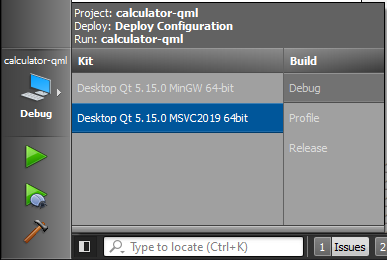
You can configure your kit by going to Tools --> Options --> Kits.
TIP
For multiple open projects, when you add an class the class maybe put in the other projects folder. That's why its better to work one at a time.
# First QML application
Remember QML is the language Qt Quick is the foundation. The actual components that we're going to use, to build that application.
So, go New Project --> Qt Quick application and choose:
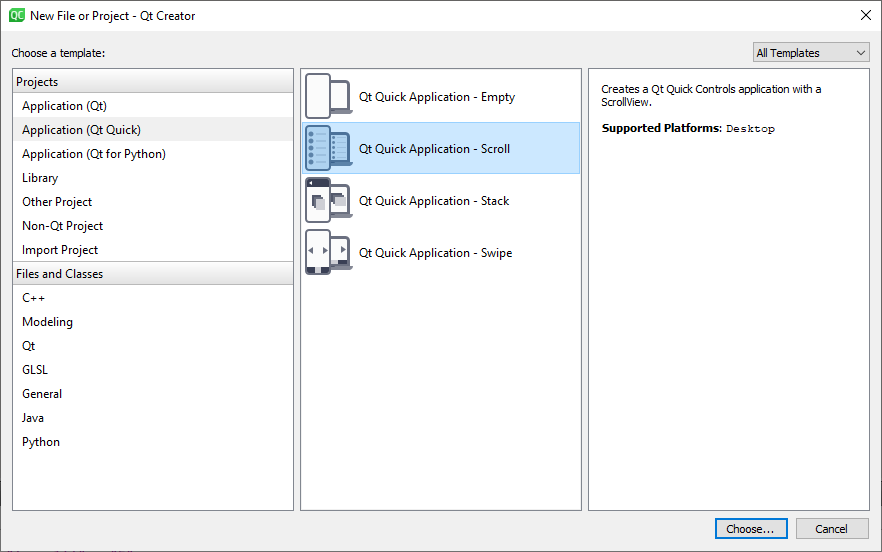
Now the difference between QML and Qt Quick is right here.
This is all QML, but these individual widgets or components those are Qt Quick.
import QtQuick 2.12
import QtQuick.Controls 2.5
ApplicationWindow {
visible: true
width: 640
height: 480
title: qsTr("Scroll")
ScrollView {
anchors.fill: parent
ListView {
width: parent.width
model: 20
delegate: ItemDelegate {
text: "Item " + (index + 1)
width: parent.width
}
}
}
}
2
3
4
5
6
7
8
9
10
11
12
13
14
15
16
17
18
19
20
21
22
at the main.cpp we have:
#include <QGuiApplication>
#include <QQmlApplicationEngine>
int main(int argc, char *argv[])
{
QCoreApplication::setAttribute(Qt::AA_EnableHighDpiScaling);
QGuiApplication app(argc, argv);
QQmlApplicationEngine engine;
const QUrl url(QStringLiteral("qrc:/main.qml"));
QObject::connect(&engine, &QQmlApplicationEngine::objectCreated,
&app, [url](QObject *obj, const QUrl &objUrl) {
if (!obj && url == objUrl)
QCoreApplication::exit(-1);
}, Qt::QueuedConnection);
engine.load(url);
return app.exec();
}
2
3
4
5
6
7
8
9
10
11
12
13
14
15
16
17
18
19
20
Here We are just simply setting QCoreApplication::setAttribute(Qt::AA_EnableHighDpiScaling); that's for devices. Some devices enable that some don't.
They are specific for cell phones, really, actually shouldn't say specific for cell phones, but cell phones use that quite a bit.
Then, we're making a QGuiApplication app(argc, argv); and just starting out our event loop here return app.exec();
Then, we have a QQmlApplicationEngine engine; application engine, big long class name, But basically, this is the engine that's going to run the actual file, and you notice right off the bat this is in a resource const QUrl url(QStringLiteral("qrc:/main.qml"));.
Previous versions would actually have these QML files out on the hard drive, and you would have to distribute the binary and the QML file.
That's all a thing of the past.
Now, everything's compiled right in as a resource.
So, you just have to distribute your binary with the cute libraries, of course.
Then we have a QObject::connect Object.
Really what that's doing is just some safety checking.
Saying, hey, if it's not the right url and object then we're just going to exit with -1.
The magic really is the engine.load(url);
So we're just loading this into the engine, and what is getting load is the QML file.
# Creating an empty Qt Quick application
This would be the "Hello World" of QML
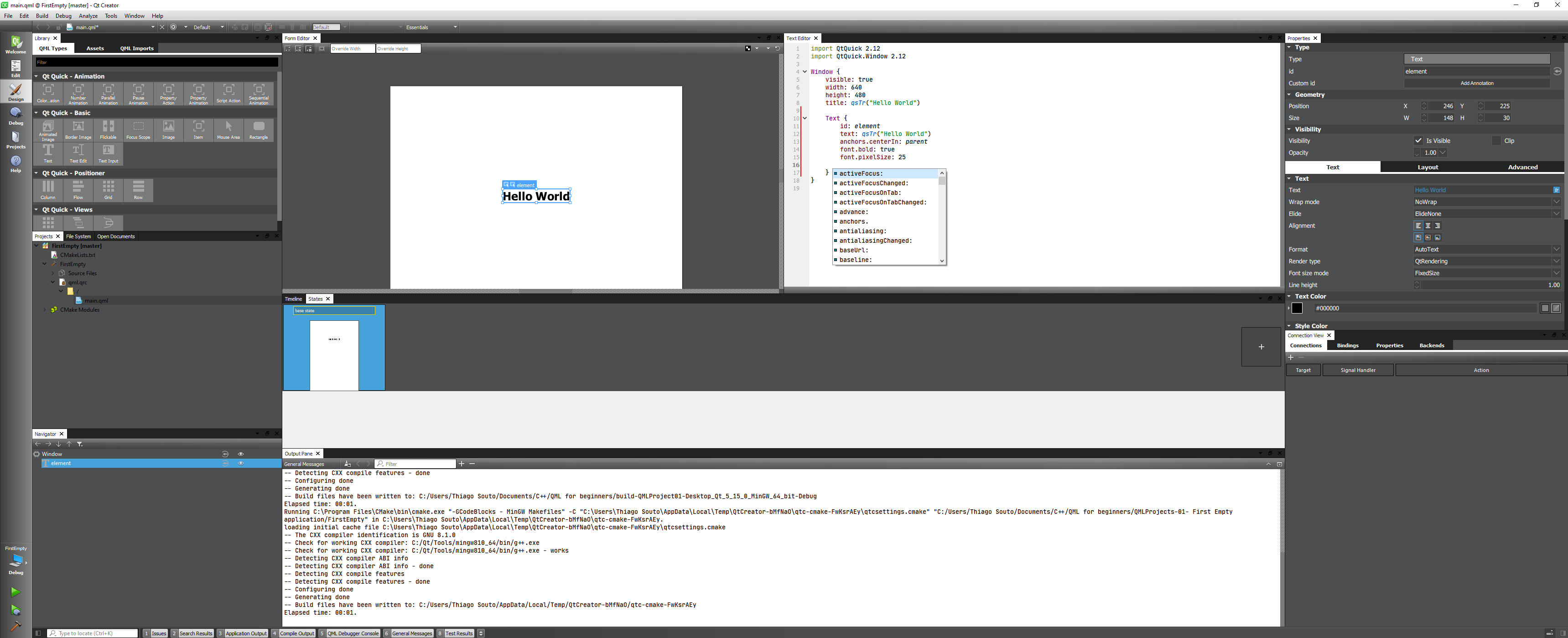
TIP
CRTL + Space for intellisense
and if you select something and F1 you bring the integrated help file.
# Interesting questions
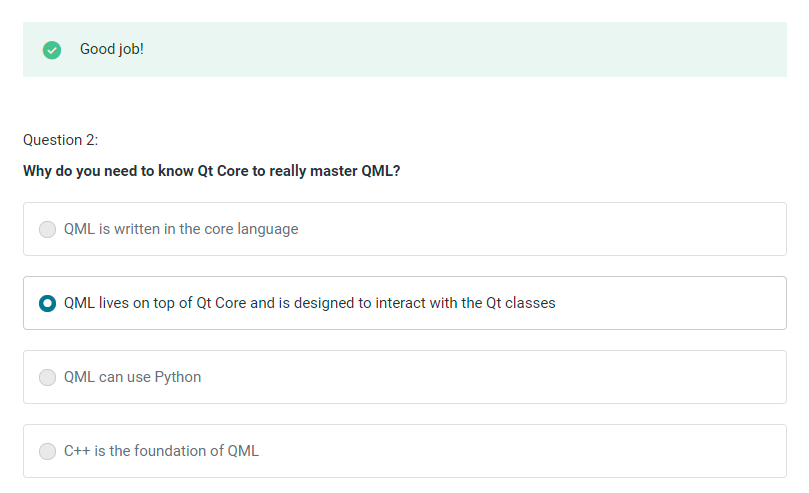
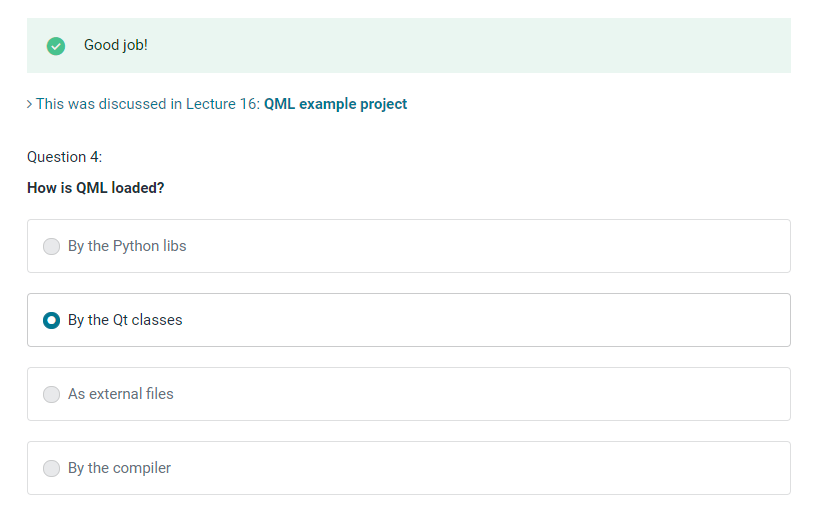
# Section 3: Diving into QML
# First Program with an image
Image from the web:
import QtQuick 2.12
import QtQuick.Window 2.12
Window {
width: 640
height: 480
visible: true
title: qsTr("Hello World")
Image {
id: myimage
source: "https://upload.wikimedia.org/wikipedia/commons/0/0b/Qt_logo_2016.svg"
anchors.centerIn: parent
}
}
2
3
4
5
6
7
8
9
10
11
12
13
14
15
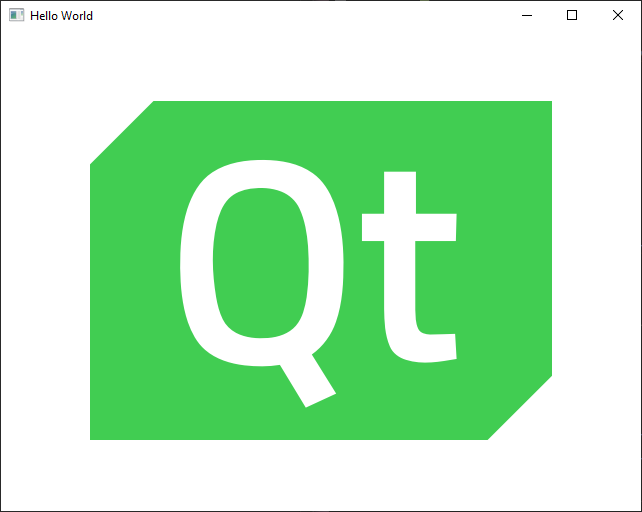
TIP
Comments are like normal C++
//This is a comment!!!
/*
This is a multi-line comment
*/
2
3
4
5
Image from the computer:
First we have to add the source to the qml.qrc. So right click on qml.qrc -> Open With -> Resource Editor.
Then right click on the image and copy URL.
import QtQuick 2.12
import QtQuick.Window 2.12
Window {
width: 640
height: 480
visible: true
title: qsTr("Hello World")
//This is a comment!!!
/*
This is a multi-line comment
*/
Image {
id: myimage
source: "qrc:/IMAGES/16-ShadersClass-02.png"
anchors.centerIn: parent
}
}
2
3
4
5
6
7
8
9
10
11
12
13
14
15
16
17
18
19
20
21
TIP
ID must be unique
Root Object - There can be only one
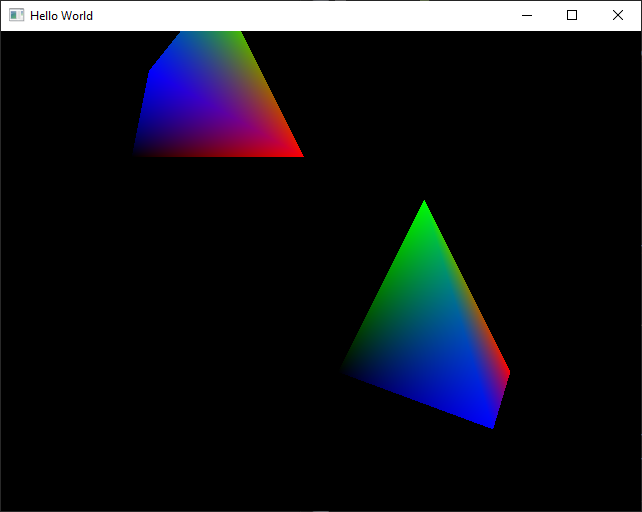
An image with a rectangle inside of it:
import QtQuick 2.12
import QtQuick.Window 2.12
Window {
width: 640
height: 480
visible: true
title: qsTr("Hello World")
id: root
Image {
id: myimage
source: "qrc:/IMAGES/16-ShadersClass-02.png"
width: 150
height: 100
Rectangle {
color: "red"
width: parent.width
height: parent.height
opacity: 0.5 // 50%
}
}
}
2
3
4
5
6
7
8
9
10
11
12
13
14
15
16
17
18
19
20
21
22
23
24
Centering in the window:
import QtQuick 2.12
import QtQuick.Window 2.12
Window {
width: 640
height: 480
visible: true
title: qsTr("Hello World")
id: root
Image {
id: myimage
source: "qrc:/IMAGES/16-ShadersClass-02.png"
width: 150
height: 100
anchors.centerIn: parent
Rectangle {
color: "red"
width: parent.width
height: parent.height
opacity: 0.5 // 50%
}
}
}
2
3
4
5
6
7
8
9
10
11
12
13
14
15
16
17
18
19
20
21
22
23
24
25
The Top level object is the root object and there can be only one root object
TIP
Now let's talk about why can there only be one.
It's the way Q does memory management if you understand QT core, QT uses what's called a parent child hierarchy to manage memory.
So when the parent is destroyed all subsequent children are destroyed also.
So it only has to track one object.
if we come to the main.cpp file we can see that the engine is loading the url.
#include <QGuiApplication>
#include <QQmlApplicationEngine>
int main(int argc, char *argv[])
{
QCoreApplication::setAttribute(Qt::AA_EnableHighDpiScaling);
QGuiApplication app(argc, argv);
QQmlApplicationEngine engine;
const QUrl url(QStringLiteral("qrc:/main.qml"));
QObject::connect(&engine, &QQmlApplicationEngine::objectCreated,
&app, [url](QObject *obj, const QUrl &objUrl) {
if (!obj && url == objUrl)
QCoreApplication::exit(-1);
}, Qt::QueuedConnection);
engine.load(url);
return app.exec();
}
2
3
4
5
6
7
8
9
10
11
12
13
14
15
16
17
18
19
20
# QML objects vs QObjects
Creating a text input on the image
import QtQuick 2.12
import QtQuick.Window 2.12
Window {
width: 640
height: 480
visible: true
title: qsTr("Hello World")
id: root
Image {
id: myimage
source: "qrc:/IMAGES/16-ShadersClass-02.png"
width: 150
height: 100
anchors.centerIn: parent
opacity: 0.25
}
TextInput {
id:myinput
text: "Hello World"
anchors.centerIn: parent
}
}
2
3
4
5
6
7
8
9
10
11
12
13
14
15
16
17
18
19
20
21
22
23
24
25
Binding text with the input text
import QtQuick 2.12
import QtQuick.Window 2.12
Window {
width: 640
height: 480
visible: true
title: qsTr("Hello World")
id: root
Image {
id: myimage
source: "qrc:/IMAGES/16-ShadersClass-02.png"
width: 150
height: 100
anchors.centerIn: parent
opacity: 0.25
}
TextInput {
id:myInput
text: "Hello World"
anchors.centerIn: parent
font.pixelSize: 25
}
Text {
id:myText
text: myInput.text
font.pixelSize: 25
}
}
2
3
4
5
6
7
8
9
10
11
12
13
14
15
16
17
18
19
20
21
22
23
24
25
26
27
28
29
30
31
32
So we're gonna go to this text input and you can see it in real time changing up here so as we type that signal is emitted and it's going out to that slot and that's all happening because of property bindings.
There's a lot more that actually happens under the hood but I wanted you to be aware that that's kind of what's going on here.
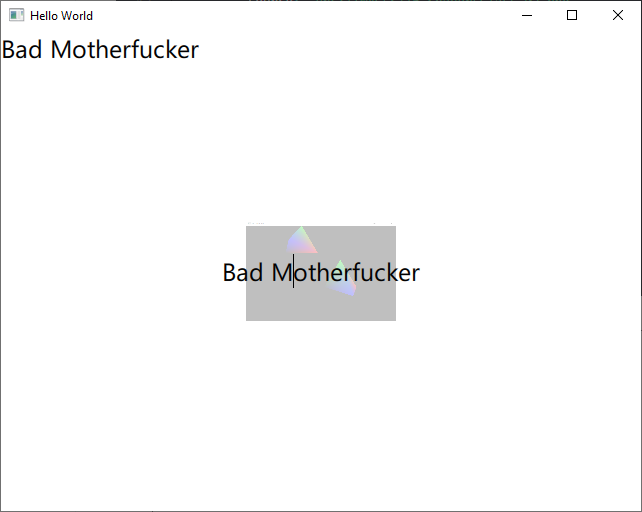
# X, Y, Z positioning
import QtQuick 2.12
import QtQuick.Window 2.12
Window {
width: 640
height: 480
visible: true
title: qsTr("Hello World")
id: root
Image {
id: myimage
source: "qrc:/IMAGES/16-ShadersClass-02.png"
width: 150
height: 100
x: 100
y: 100
}
Rectangle {
color: "red"
width: 200
height: 200
x: 50
y: 50
opacity: 0.5
}
Rectangle {
color: "blue"
width: 200
height: 200
x: 150
y: 150
opacity: 0.5
}
}
2
3
4
5
6
7
8
9
10
11
12
13
14
15
16
17
18
19
20
21
22
23
24
25
26
27
28
29
30
31
32
33
34
35
36
37
Using Z to position the layers
import QtQuick 2.12
import QtQuick.Window 2.12
Window {
width: 640
height: 480
visible: true
title: qsTr("Hello World")
id: root
Image {
id: myimage
source: "qrc:/IMAGES/16-ShadersClass-02.png"
width: 150
height: 100
x: 100
y: 100
z: 4
}
Rectangle {
color: "red"
width: 200
height: 200
x: 50
y: 50
z: 2
opacity: 0.5
}
Rectangle {
color: "blue"
width: 200
height: 200
x: 150
y: 150
z: 1
opacity: 0.5
}
}
2
3
4
5
6
7
8
9
10
11
12
13
14
15
16
17
18
19
20
21
22
23
24
25
26
27
28
29
30
31
32
33
34
35
36
37
38
39
40
TIP
The lower the Z the lower the position
If the Z is all the same, the last image on the stack stays on top.
import QtQuick 2.12
import QtQuick.Window 2.12
Window {
width: 640
height: 480
visible: true
title: qsTr("Hello World")
id: root
Rectangle {
color: "red"
width: 200
height: 200
x: 50
y: 50
z: 0
opacity: 0.5
}
Rectangle {
color: "blue"
width: 200
height: 200
x: 150
y: 150
z: 0
opacity: 0.5
}
Image {
id: myimage
source: "qrc:/IMAGES/16-ShadersClass-02.png"
width: 150
height: 100
x: 100
y: 100
z: 0
}
}
2
3
4
5
6
7
8
9
10
11
12
13
14
15
16
17
18
19
20
21
22
23
24
25
26
27
28
29
30
31
32
33
34
35
36
37
38
39
40
# Parent and child transformations
# Parent and children Relationships
Because the rectangle is a child of the image the location is related to the image and not to the window
import QtQuick 2.12
import QtQuick.Window 2.12
Window {
width: 640
height: 480
visible: true
title: qsTr("Hello World")
id: root
Image {
id: myimage
source: "qrc:/IMAGES/16-ShadersClass-02.png"
width: 150
height: 100
x: 100
y: 100
z: 0
Rectangle {
color: "red"
width: 50
height: 50
x: 0
y: 0
z: 0
opacity: 0.5
}
}
}
2
3
4
5
6
7
8
9
10
11
12
13
14
15
16
17
18
19
20
21
22
23
24
25
26
27
28
29
30
Another example where the relationship between parent and child is used to position a rectangle in the bottom right corner.
import QtQuick 2.12
import QtQuick.Window 2.12
Window {
width: 640
height: 480
visible: true
title: qsTr("Hello World")
id: root
Image {
id: myimage
source: "qrc:/IMAGES/16-ShadersClass-02.png"
width: 150
height: 100
x: 100
y: 100
z: 0
Rectangle {
color: "red"
width: 50
height: 50
x: 0
y: 0
opacity: 0.5
}
Rectangle {
color: "red"
x: parent.width - width
y: parent.height - height
width: 50
height: 50
opacity: 0.5
}
}
}
2
3
4
5
6
7
8
9
10
11
12
13
14
15
16
17
18
19
20
21
22
23
24
25
26
27
28
29
30
31
32
33
34
35
36
37
38
An important thing to notice is that the parent will always be on the bottom layer no matter the z position. Although there are some ways to do that its not the rule.
import QtQuick 2.12
import QtQuick.Window 2.12
Window {
width: 640
height: 480
visible: true
title: qsTr("Hello World")
id: root
Image {
id: myimage
source: "qrc:/IMAGES/16-ShadersClass-02.png"
width: 150
height: 100
x: 100
y: 100
z: 3
Rectangle {
color: "red"
width: 50
height: 50
x: -25
y: -25
z: 1
opacity: 0.5
}
Rectangle {
color: "red"
x: parent.width - width
y: parent.height - height
z: 0
width: 50
height: 50
opacity: 0.5
}
}
}
2
3
4
5
6
7
8
9
10
11
12
13
14
15
16
17
18
19
20
21
22
23
24
25
26
27
28
29
30
31
32
33
34
35
36
37
38
39
40
TIP
Consider the parent as a table top and the children are layed on top of the table.
# Object interaction - TapHandler
This program will change the color of the rectangle between blue and red when its pressed.
import QtQuick 2.12
import QtQuick.Window 2.12
Window {
width: 640
height: 480
visible: true
title: qsTr("Hello World")
Rectangle {
anchors.centerIn: parent
width: 100
height: 100
color: inputHandler.pressed ? "red" : "blue"
TapHandler {
id: inputHandler
}
}
}
2
3
4
5
6
7
8
9
10
11
12
13
14
15
16
17
18
19
20
21
Challenge: Code a program with 2 rectangles with independent TapHandle
import QtQuick 2.12
import QtQuick.Window 2.12
Window {
width: 640
height: 480
visible: true
title: qsTr("Hello World")
Rectangle {
anchors.centerIn: parent
width: 100
height: 100
id: rect1
color: inputHandler.pressed ? "red" : "blue"
TapHandler {
id: inputHandler
}
}
Rectangle {
anchors.right: rect1.left; anchors.rightMargin: 50
anchors.bottom: rect1.bottom
width: 100
height: 100
id: rect2
color: inputHandler2.pressed ? "red" : "blue"
TapHandler {
id: inputHandler2
}
}
}
2
3
4
5
6
7
8
9
10
11
12
13
14
15
16
17
18
19
20
21
22
23
24
25
26
27
28
29
30
31
32
33
34
35
36
# Section 4: Basic types
# Item QML type
Item is the QML version of the QObject.
It defines anchors, it defines antiliasing, children, the children rectangle, clipping, data, on and on and on and on.
import QtQuick 2.12
import QtQuick.Window 2.12
Window {
width: 640
height: 480
visible: true
title: qsTr("Hello World")
Item {
id: myItem
anchors.centerIn: parent
width: 100
height: 100
Rectangle {
color: "red"
anchors.fill: parent
}
}
}
2
3
4
5
6
7
8
9
10
11
12
13
14
15
16
17
18
19
20
21
The power of the item component doesn't really come into play until you get a little bit more advanced; and that's why it's one of the most misunderstood terms.
They push this on you early because it is the base for all visual types, but it itself is non visual, and it makes no sense why this thing even exists.
It exists solely so that you can make your own components, and you can say I want to define my own custom object.
# Rectangle
Its an Item.
There is no circle
import QtQuick 2.12
import QtQuick.Window 2.12
Window {
width: 640
height: 480
visible: true
title: qsTr("Hello World")
Rectangle {
id: myItem
anchors.centerIn: parent
color: "red"
width: 200
height: 200
visible: true //code just to exemplify that you can have an invisible one.
border.color: "black"
border.width: 5
}
}
2
3
4
5
6
7
8
9
10
11
12
13
14
15
16
17
18
19
20
21
import QtQuick 2.12
import QtQuick.Window 2.12
Window {
width: 640
height: 480
visible: true
title: qsTr("Hello World")
Rectangle {
id: myItem
anchors.centerIn: parent
color: "red"
width: 200
height: 200
visible: true //code just to exemplify that you can have an invisible one.
border.color: "black"
border.width: 5
radius: 30
}
}
2
3
4
5
6
7
8
9
10
11
12
13
14
15
16
17
18
19
20
21
22
23
import QtQuick 2.12
import QtQuick.Window 2.12
Window {
width: 640
height: 480
visible: true
title: qsTr("Hello World")
Rectangle {
id: myItem
anchors.centerIn: parent
color: "red"
width: 200
height: 200
visible: true //code just to exemplify that you can have an invisible one.
border.color: "black"
border.width: 5
radius: width
}
}
2
3
4
5
6
7
8
9
10
11
12
13
14
15
16
17
18
19
20
21
22
23
# Gradients
So what we're doing is we're saying the gradient property of the rectangle. We're going to create a new child called a gradient.
import QtQuick 2.12
import QtQuick.Window 2.12
Window {
width: 640
height: 480
visible: true
title: qsTr("Hello World")
Rectangle {
id: myItem
anchors.centerIn: parent
color: "red"
width: 200
height: 200
visible: true //code just to exemplify that you can have an invisible one.
border.color: "black"
border.width: 5
radius: width
gradient: Gradient {
GradientStop {position: 0.0; color: "red"}
GradientStop {position: 1.0; color: "blue"}
}
}
}
2
3
4
5
6
7
8
9
10
11
12
13
14
15
16
17
18
19
20
21
22
23
24
25
26
27
28
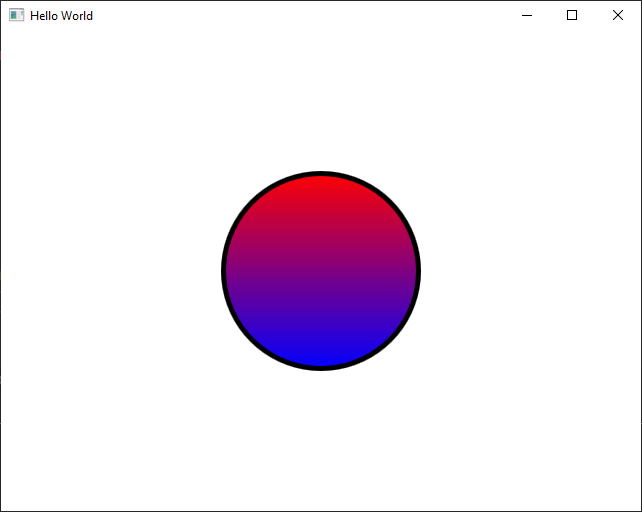
# Image QML Type
This thing is awesome.
You can actually build upon this and do like an animated image or an animated sprite so you can actually do animations very quickly.
WARNING
Image source with local or remote file there's something you need to be aware of.
First off this uses open geo meaning it's lightning quick.
One of the caveats being is that if you have a local file, that local file is preloaded when your application starts. So if you have a massive graphic it's going to try and load that application start which will kill your startup time. So buyer beware.
Don't load massive graphics into a program
a .qrc file is a qT resource content file, meaning everything in this file gets compiled and baked right into the binary executable which includes our .qml file that we've been working with.
We're just gonna right click open with resource editor; and we're gonna add a prefix, prefix is just a fancy term for virtual directory. So we're gonna make a virtual directory called images.
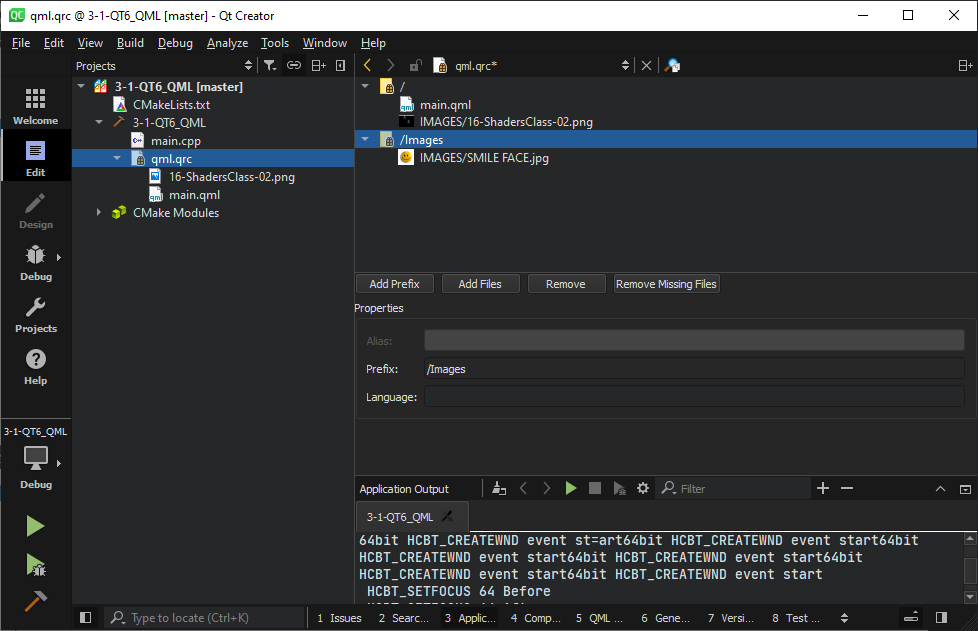
import QtQuick 2.12
import QtQuick.Window 2.12
Window {
width: 640
height: 480
visible: true
title: qsTr("Hello World")
Image {
id: localImage
source: "Images/IMAGES/SMILE FACE.jpg"
width: 500
fillMode: Image.PreserveAspectFit
}
}
2
3
4
5
6
7
8
9
10
11
12
13
14
15
16
17
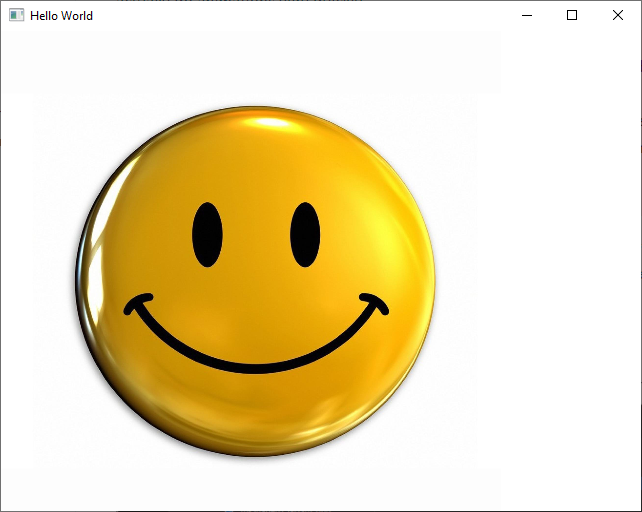
Now we want to try and position this and I'm gonna make what's called a property, which has a type a name and a value.
import QtQuick 2.12
import QtQuick.Window 2.12
Window {
width: 640
height: 480
visible: true
title: qsTr("Hello World")
property var middle: height / 2
Image {
id: localImage
source: "Images/IMAGES/SMILE FACE.jpg"
width: 300
fillMode: Image.PreserveAspectFit
x: 300
y: middle - 100
}
}
2
3
4
5
6
7
8
9
10
11
12
13
14
15
16
17
18
19
20
21
22
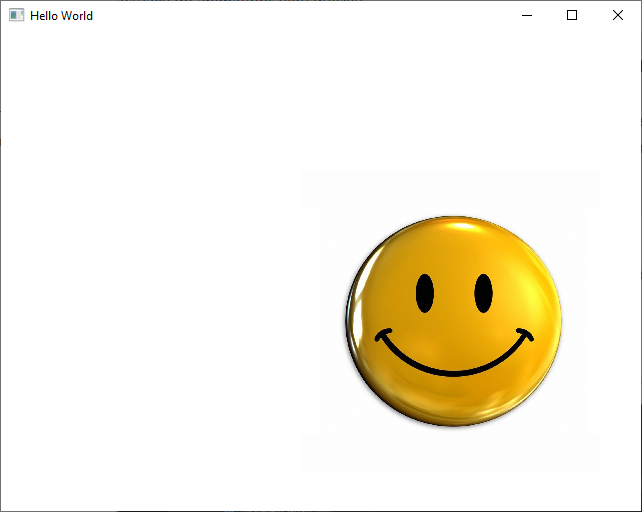
TIP
You can refer to a web url.
import QtQuick 2.12
import QtQuick.Window 2.12
Window {
width: 640
height: 480
visible: true
title: qsTr("Hello World")
property var middle: height / 2
Image {
id: localImage
source: "Images/IMAGES/SMILE FACE.jpg"
width: 300
fillMode: Image.PreserveAspectFit
x: 300
y: middle - 100
}
Image {
id: remoteImage
source: "https://upload.wikimedia.org/wikipedia/commons/d/d3/Qt_logo_2015.svg"
width: 100
fillMode: Image.PreserveAspectFit
x: 100
y: middle
onProgressChanged: console.log(remoteImage.progress)
onStatusChanged: if(remoteImage.status == image.Ready) console.log("Remote image loaded")
}
}
2
3
4
5
6
7
8
9
10
11
12
13
14
15
16
17
18
19
20
21
22
23
24
25
26
27
28
29
30
31
32
33
34
35
36
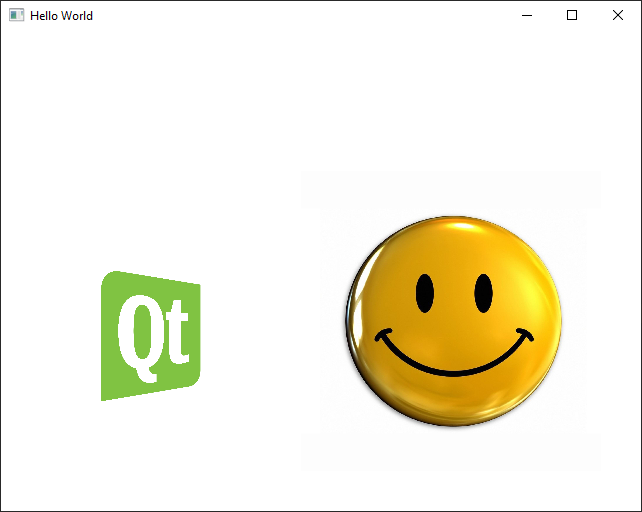
# Text
import QtQuick 2.12
import QtQuick.Window 2.12
Window {
width: 640
height: 480
visible: true
title: qsTr("Hello World")
Text {
id: myText
text: qsTr("<html><b>Hello</b><i><font color='green'>World </font></i><html>")
anchors.centerIn: parent
font.pointSize: 35
font.bold: true
font.italic: false
}
}
2
3
4
5
6
7
8
9
10
11
12
13
14
15
16
17
18
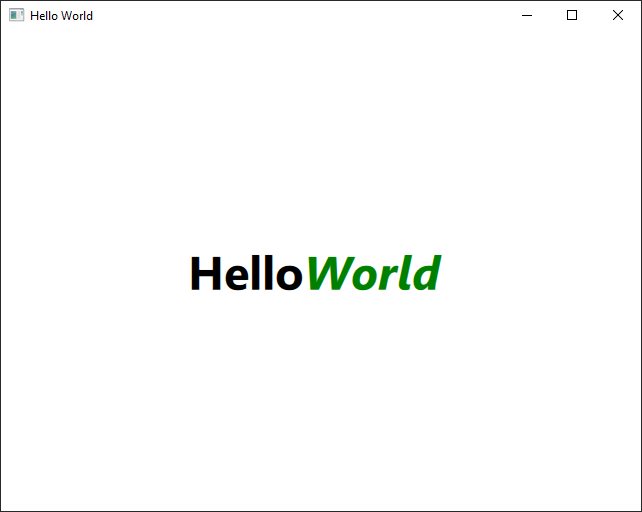
TIP
If the inline html is overridden by the QML font property sometimes it will not work.
We can also format the html on the code like this:
import QtQuick 2.12
import QtQuick.Window 2.12
Window {
width: 640
height: 480
visible: true
title: qsTr("Hello World")
Text {
id: myText
text: qsTr("
<html>
<b>Hello</b>
<i><font color='green'>World</font></i><br>
<font color='#C0C0C0'>This is a test</font>
<html>
")
anchors.centerIn: parent
font.pointSize: 35
font.bold: true
font.italic: false
}
}
2
3
4
5
6
7
8
9
10
11
12
13
14
15
16
17
18
19
20
21
22
23
24
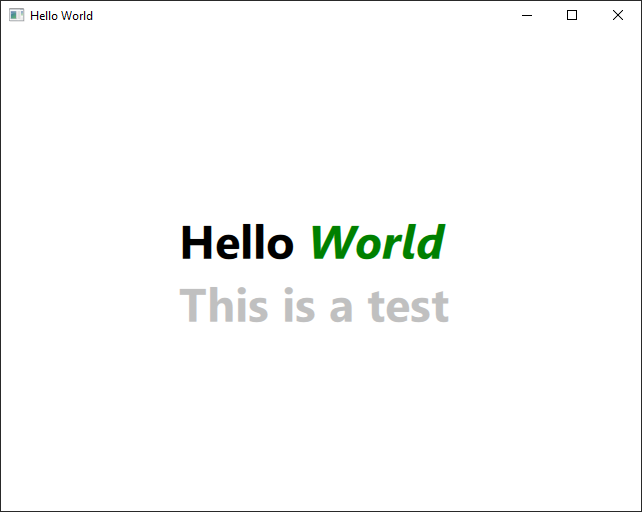
We can use a href from html:
import QtQuick 2.12
import QtQuick.Window 2.12
Window {
width: 640
height: 480
visible: true
title: qsTr("Hello World")
Text {
id: myText
text: qsTr("
<html>
<b>Hello</b>
<i><font color='green'>World</font></i><br>
<font color='#C0C0C0'>This is a test</font><br>
<a href='https://www.skinnyrobot.co.nz'>Skinny Robot</a>
<html>
")
onLinkActivated: Qt.openUrlExternally(link);
anchors.centerIn: parent
font.pointSize: 35
font.bold: true
font.italic: false
}
}
2
3
4
5
6
7
8
9
10
11
12
13
14
15
16
17
18
19
20
21
22
23
24
25
26
TIP
Remember to use this onLinkActivated: Qt.openUrlExternally(link);, or it will not work
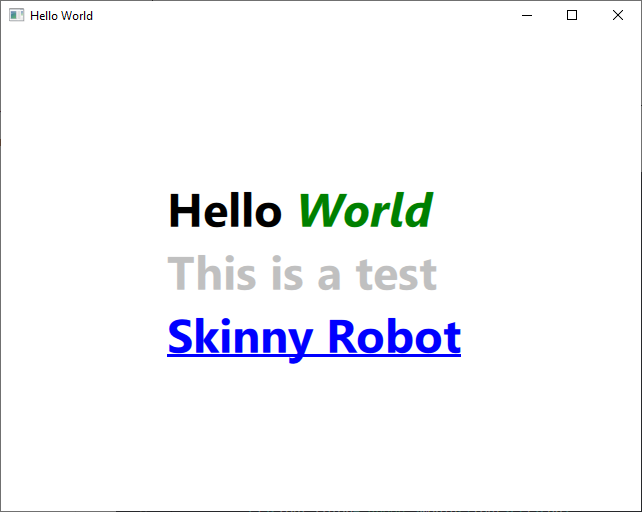
We can also play with some basic javascript, and change the text to bold and back on mouse hover.
import QtQuick 2.12
import QtQuick.Window 2.12
Window {
width: 640
height: 480
visible: true
title: qsTr("Hello World")
Text {
id: myText
text: qsTr("
<html>
<b>Hello</b>
<i><font color='green'>World</font></i><br>
<font color='#C0C0C0'>This is a test</font><br>
<a href='https://www.skinnyrobot.co.nz'>Skinny Robot</a>
<html>
")
onLinkHovered: {
console.log("Hover: " + link)
if(link) {
myText.font.bold = true
} else {
myText.font.bold = false
}
}
onLinkActivated: Qt.openUrlExternally(link);
anchors.centerIn: parent
font.pointSize: 35
font.bold: true
font.italic: false
}
}
2
3
4
5
6
7
8
9
10
11
12
13
14
15
16
17
18
19
20
21
22
23
24
25
26
27
28
29
30
31
32
33
34
35
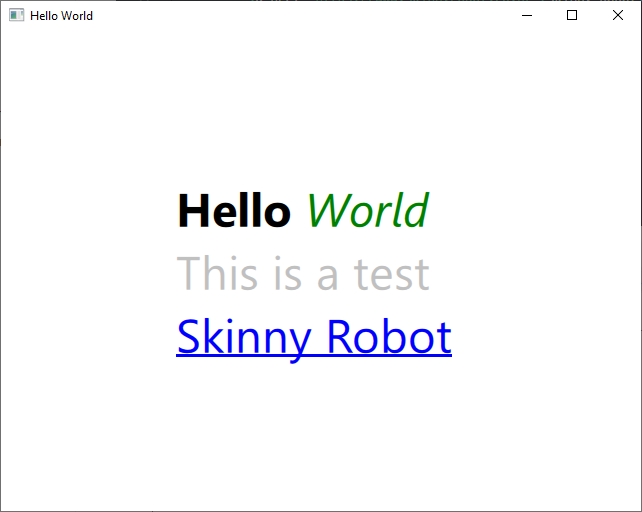
# Mouse Area
import QtQuick 2.12
import QtQuick.Window 2.12
Window {
width: 640
height: 480
visible: true
title: qsTr("Hello World")
Rectangle {
id: myItem
color: "blue"
width: 200
height: 200
anchors.centerIn: parent
MouseArea {
id: myMouse
anchors.fill: parent
acceptedButtons: Qt.LeftButton | Qt.RightButton
hoverEnabled: true
onClicked: {
console.log("Clicked: " + mouse.button)
if(mouse.button === Qt.LeftButton) parent.color = "green"
if(mouse.button === Qt.RightButton) parent.color = "red"
}
onDoubleClicked: console.log("Double Clicked: " + mouse.button)
onPositionChanged: console.log("Position X: " + mouseX + " Y: " + mouseY)
onEntered: parent.color = "orange"
onExited: parent.color = "blue"
}
}
}
2
3
4
5
6
7
8
9
10
11
12
13
14
15
16
17
18
19
20
21
22
23
24
25
26
27
28
29
30
31
32
33
34
35
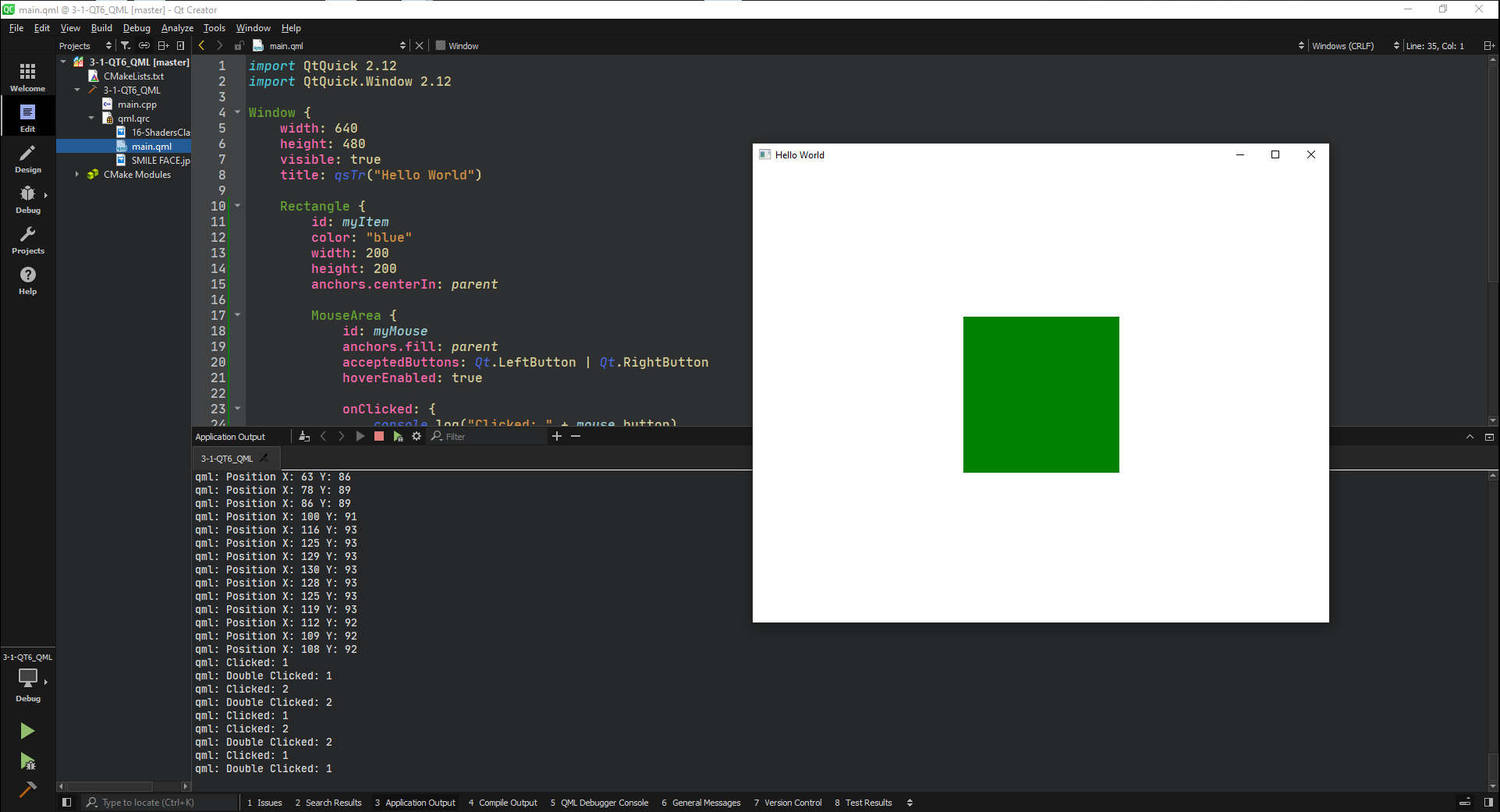
TIP
And let's just recap here is you have to acceptedButtons if you want anything more than a left button.
hoverEnabled has to be true, if you want to monitor position, onEntered or onExited.
Double click and click work by default, but again it's going to backbone on your accepted buttons and of course you have to have this fill some type of area.
You can either drop an anchor or you can do a width and height.
# Custom component
To create a custom component go to the resource file and Add New --> QT --> QML File --> Use CamelCase to name the file.
Check if it went well by checking the intellisense (Write the beginning of the component name) on the main.qml.
MyButton.qml
import QtQuick 2.0
Item {
id: root
width: 100
height: 100
property color color: "#C0C0C0"
property color colorClicked: "green"
property string title: "Click Me"
Rectangle {
id: myRec
anchors.fill: parent
color: root.color
Text {
id: display
text: root.title
anchors.centerIn: parent
}
MouseArea {
id: mouseArea
anchors.fill: parent
onPressed: parent.color = root.colorClicked
onReleased: parent.color = root.color
}
}
}
2
3
4
5
6
7
8
9
10
11
12
13
14
15
16
17
18
19
20
21
22
23
24
25
26
27
28
29
30
main.qml
import QtQuick 2.12
import QtQuick.Window 2.12
Window {
width: 640
height: 480
visible: true
title: qsTr("Hello World")
property var middle: (height / 2) - 50
MyButton {
id: button1
x: 100
y: middle
color: "red"
colorClicked: "orange"
title: "Button 1"
}
MyButton {
id: button2
x: (parent.width / 2) - (width / 2)
y: middle
color: "blue"
colorClicked: "orange"
title: "Button 2"
}
MyButton {
id: button3
x: parent.width - 200
y: middle
color: "green"
colorClicked: "orange"
title: "Button 3 <br> Testing"
}
MyButton {
id: button4
x: (parent.width / 2) - (width / 2)
y: middle + 120
width: 500
height: 40
color: "lightblue"
colorClicked: "orange"
title: "<b>Super</b> <i>Long</i> <u>Button</u>"
}
}
2
3
4
5
6
7
8
9
10
11
12
13
14
15
16
17
18
19
20
21
22
23
24
25
26
27
28
29
30
31
32
33
34
35
36
37
38
39
40
41
42
43
44
45
46
47
48
49
50
51
52
# Section 5
# Object positioning using X, Y
TIP
Then anchors will always win the position settings.
When you set an anchors QML ignores any manual positioning
import QtQuick 2.12
import QtQuick.Window 2.12
Window {
width: 640
height: 480
visible: true
title: qsTr("Hello World")
Rectangle {
id: myShape
width: 100
height: 100
color: "orange"
function update() {
console.log(x + " x " + y)
label.text = Math.round(x) + " x " + Math.round(y)
}
x: 100
y: 100
// anchors.centerIn: parent
Component.onCompleted: update()
Text {
id: label
text: qsTr("text")
anchors.centerIn: parent
}
MouseArea {
anchors.fill: parent
}
}
}
2
3
4
5
6
7
8
9
10
11
12
13
14
15
16
17
18
19
20
21
22
23
24
25
26
27
28
29
30
31
32
33
34
35
36
37
and if we use the anchors the value will be wrong because the manual positioning will be ignored
import QtQuick 2.12
import QtQuick.Window 2.12
Window {
width: 640
height: 480
visible: true
title: qsTr("Hello World")
Rectangle {
id: myShape
width: 100
height: 100
color: "orange"
function update() {
console.log(x + " x " + y)
label.text = Math.round(x) + " x " + Math.round(y)
}
x: 100
y: 100
anchors.centerIn: parent
Component.onCompleted: update()
Text {
id: label
text: qsTr("text")
anchors.centerIn: parent
}
MouseArea {
anchors.fill: parent
}
}
}
2
3
4
5
6
7
8
9
10
11
12
13
14
15
16
17
18
19
20
21
22
23
24
25
26
27
28
29
30
31
32
33
34
35
36
37
Now let's update our rectangle position based on the mouse drag.
import QtQuick 2.12
import QtQuick.Window 2.12
Window {
width: 640
height: 480
visible: true
title: qsTr("Hello World")
Rectangle {
id: myShape
width: 100
height: 100
color: "orange"
function update() {
console.log(x + " x " + y)
label.text = Math.round(x) + " x " + Math.round(y)
}
x: 100
y: 100
onXChanged: update()
onYChanged: update()
// @disable-check M16
Component.onCompleted: update()
Text {
id: label
text: qsTr("text")
anchors.centerIn: parent
}
MouseArea {
anchors.fill: parent
drag.target: parent
}
}
}
2
3
4
5
6
7
8
9
10
11
12
13
14
15
16
17
18
19
20
21
22
23
24
25
26
27
28
29
30
31
32
33
34
35
36
37
38
39
40
import QtQuick 2.12
import QtQuick.Window 2.12
Window {
width: 640
height: 480
visible: true
title: qsTr("Hello World")
Rectangle {
id: myShape
width: 100
height: 100
color: "orange"
function update() {
console.log(x + " x " + y)
label.text = Math.round(x) + " x " + Math.round(y)
}
x: 100
y: 100
onXChanged: update()
onYChanged: update()
// @disable-check M16
// Component.onCompleted: update()
Text {
id: label
text: qsTr("text")
anchors.centerIn: parent
}
MouseArea {
anchors.fill: parent
drag.target: parent
}
}
}
2
3
4
5
6
7
8
9
10
11
12
13
14
15
16
17
18
19
20
21
22
23
24
25
26
27
28
29
30
31
32
33
34
35
36
37
38
39
40
TIP
// @disable-check M16, is a necessary comment for a bug in the type info that is generated for controls for use of QtCreator
Obs.: Component.onCompleted: update() is necessary in this case because we want the numbers to appear as soon as the component is loaded, otherwise it would be just the text.
# Object positioning using Z
This example will help us understand the z drag axis.
For this we will add a new QML file.
MyShape.qml
import QtQuick 2.0
Rectangle {
width: 100
height: 100
color: "gray"
MouseArea {
anchors.fill: parent
drag.target: parent
onClicked: parent.z++
}
}
2
3
4
5
6
7
8
9
10
11
12
13
on this component we are going to increment the z position when clicked.
import QtQuick 2.12
import QtQuick.Window 2.12
Window {
width: 640
height: 480
visible: true
title: qsTr("Hello World")
MyShape {
color: "red"
}
}
2
3
4
5
6
7
8
9
10
11
12
13
So with this we have a red rectangle that can be dragged around.
Lastly, we are going to mess around with the initial positions se we can have it more organized on the begining of the program
import QtQuick 2.12
import QtQuick.Window 2.12
Window {
width: 640
height: 480
visible: true
title: qsTr("Hello World")
property var midX: width / 2
property var midY: height / 2
MyShape {
color: "red"
x: midX - (width / 2)
y: midY - (height / 2) - 30
}
MyShape {
color: "green"
x: midX - (width / 2) - 55
y: midY - (height / 2) + 30
}
MyShape {
color: "blue"
x: midX - (width / 2) + 55
y: midY - (height / 2) + 30
}
}
2
3
4
5
6
7
8
9
10
11
12
13
14
15
16
17
18
19
20
21
22
23
24
25
26
27
28
29
30
# Column layout
Using the same custom component from last example we are going to create a column with three components stacked with a spacing of 2 between them.
import QtQuick 2.12
import QtQuick.Window 2.12
Window {
width: 640
height: 480
visible: true
title: qsTr("Hello World")
Column {
anchors.centerIn: parent
spacing: 2
MyShape { color: "red" }
MyShape { color: "green" }
MyShape { color: "blue" }
}
}
2
3
4
5
6
7
8
9
10
11
12
13
14
15
16
17
Of course we can still move things around and play with the z position on click.
# Row layout
Self explanatory
import QtQuick 2.12
import QtQuick.Window 2.12
Window {
width: 640
height: 480
visible: true
title: qsTr("Hello World")
Row {
anchors.centerIn: parent
spacing: 2
MyShape { color: "red" }
MyShape { color: "green" }
MyShape { color: "blue" }
}
}
2
3
4
5
6
7
8
9
10
11
12
13
14
15
16
17
# Grid Layout
If we don't specify the number of columns or row the grid auto arrange
import QtQuick 2.12
import QtQuick.Window 2.12
Window {
width: 640
height: 480
visible: true
title: qsTr("Hello World")
Grid {
anchors.centerIn: parent
spacing: 2
MyShape { color: "red" }
MyShape { color: "green" }
MyShape { color: "blue" }
MyShape { color: "yellow" }
MyShape { color: "brown" }
MyShape { color: "purple" }
MyShape { color: "black" }
MyShape { color: "gray" }
MyShape { color: "teal" }
MyShape { color: "orange" }
}
}
2
3
4
5
6
7
8
9
10
11
12
13
14
15
16
17
18
19
20
21
22
23
24
25
Although we can specify the rows and columns, the components will be stacked in order of creation.
import QtQuick 2.12
import QtQuick.Window 2.12
Window {
width: 640
height: 480
visible: true
title: qsTr("Hello World")
Grid {
anchors.centerIn: parent
spacing: 2
rows: 1
columns: 1
MyShape { color: "red" }
MyShape { color: "green" }
MyShape { color: "blue" }
MyShape { color: "yellow" }
MyShape { color: "brown" }
MyShape { color: "purple" }
MyShape { color: "black" }
MyShape { color: "gray" }
MyShape { color: "teal" }
MyShape { color: "orange" }
}
}
2
3
4
5
6
7
8
9
10
11
12
13
14
15
16
17
18
19
20
21
22
23
24
25
26
27
Notice that the last created is the orange.
But if we move them around we can see the other ones.
3 rows and 3 columns
TIP
The order can be a little frustrating because the program will try to guess the order you like, normally it goes from top to bottom left to right.
# Flow layout
import QtQuick 2.12
import QtQuick.Window 2.12
Window {
width: 640
height: 480
visible: true
title: qsTr("Hello World")
Rectangle {
color: "pink"
anchors.centerIn: parent
width: 300
height: 400
clip: false
}
Flow {
anchors.centerIn: parent
MyShape { color: "red" }
MyShape { color: "green" }
MyShape { color: "blue" }
MyShape { color: "yellow" }
MyShape { color: "brown" }
MyShape { color: "purple" }
MyShape { color: "black" }
MyShape { color: "gray" }
MyShape { color: "teal" }
MyShape { color: "orange" }
}
}
2
3
4
5
6
7
8
9
10
11
12
13
14
15
16
17
18
19
20
21
22
23
24
25
26
27
28
29
30
31
32
33
We can define a flow orientation like TopToBottom, or LeftToRight
import QtQuick 2.12
import QtQuick.Window 2.12
Window {
width: 640
height: 480
visible: true
title: qsTr("Hello World")
Rectangle {
color: "pink"
anchors.centerIn: parent
width: 300
height: 400
clip: false
}
Flow {
anchors.centerIn: parent
flow: Flow.TopToBottom
MyShape { color: "red" }
MyShape { color: "green" }
MyShape { color: "blue" }
MyShape { color: "yellow" }
MyShape { color: "brown" }
MyShape { color: "purple" }
MyShape { color: "black" }
MyShape { color: "gray" }
MyShape { color: "teal" }
MyShape { color: "orange" }
}
}
2
3
4
5
6
7
8
9
10
11
12
13
14
15
16
17
18
19
20
21
22
23
24
25
26
27
28
29
30
31
32
33
34
35
And we can use the clip option to click the components inside the rectangle
import QtQuick 2.12
import QtQuick.Window 2.12
Window {
width: 640
height: 480
visible: true
title: qsTr("Hello World")
Rectangle {
color: "pink"
anchors.centerIn: parent
width: 300
height: 400
clip: true
Flow {
anchors.centerIn: parent
flow: Flow.LeftToRight
spacing: 5
MyShape { color: "red" }
MyShape { color: "green" }
MyShape { color: "blue" }
MyShape { color: "yellow" }
MyShape { color: "brown" }
MyShape { color: "purple" }
MyShape { color: "black" }
MyShape { color: "gray" }
MyShape { color: "teal" }
MyShape { color: "orange" }
}
}
}
2
3
4
5
6
7
8
9
10
11
12
13
14
15
16
17
18
19
20
21
22
23
24
25
26
27
28
29
30
31
32
33
34
35
36
37
# Anchors
First we are going to improve the MyShape component, by encapsulating it in an item.
import QtQuick 2.0
Item {
id: root
property color color: "gray"
property string text: "title"
width: 100
height: 100
Rectangle {
color: root.color
anchors.fill: parent
property string text: ""
Text {
text: root.text
anchors.centerIn: parent
}
MouseArea {
anchors.fill: parent
drag.target: root.parent
onClicked: root.parent.z++
}
}
}
2
3
4
5
6
7
8
9
10
11
12
13
14
15
16
17
18
19
20
21
22
23
24
25
26
27
28
import QtQuick 2.12
import QtQuick.Window 2.12
Window {
width: 640
height: 480
visible: true
title: qsTr("Hello World")
MyShape {
id: shareCentral
anchors.centerIn: parent
text: "Hello"
}
}
2
3
4
5
6
7
8
9
10
11
12
13
14
15
If we now set a rectangle inside the component but not use the anchors, it will be rendered inside the component but, sometimes, when you move the component the rectangle won't follow.
import QtQuick 2.12
import QtQuick.Window 2.12
Window {
width: 640
height: 480
visible: true
title: qsTr("Hello World")
MyShape {
id: shareCentral
anchors.centerIn: parent
text: "Hello"
Rectangle {
width: 25
height: 25
color: "pink"
}
}
}
2
3
4
5
6
7
8
9
10
11
12
13
14
15
16
17
18
19
20
21
And we can play arround with the anchors
import QtQuick 2.12
import QtQuick.Window 2.12
Window {
width: 640
height: 480
visible: true
title: qsTr("Hello World")
MyShape {
id: shareCentral
anchors.centerIn: parent
text: "Hello"
Rectangle {
width: 25
height: 25
color: "pink"
// anchors.centerIn: parent
// anchors.fill: parent
anchors.right: parent.right
anchors.bottom: parent.bottom
}
}
}
2
3
4
5
6
7
8
9
10
11
12
13
14
15
16
17
18
19
20
21
22
23
24
25
Making more MyShapes and anchoring them
import QtQuick 2.12
import QtQuick.Window 2.12
Window {
width: 640
height: 480
visible: true
title: qsTr("Hello World")
MyShape {
id: shapeCentral
anchors.centerIn: parent
text: "Center"
Rectangle {
width: 25
height: 25
color: "pink"
// anchors.centerIn: parent
// anchors.fill: parent
anchors.right: parent.right
anchors.bottom: parent.bottom
}
}
MyShape {
id: shapeTop
text: "Top"
color: "green"
anchors.bottom: shapeCentral.top
anchors.left: shapeCentral.left
}
MyShape {
id: shapeBottom
text: "Bottom"
color: "blue"
anchors.top: shapeCentral.bottom
anchors.left: shapeCentral.left
}
MyShape {
id: shapeLeft
text: "Left"
color: "red"
anchors.right: shapeCentral.left
anchors.bottom: shapeCentral.bottom
}
MyShape {
id: shapeRight
text: "Right"
color: "yellow"
anchors.left: shapeCentral.right
anchors.bottom: shapeCentral.bottom
}
}
2
3
4
5
6
7
8
9
10
11
12
13
14
15
16
17
18
19
20
21
22
23
24
25
26
27
28
29
30
31
32
33
34
35
36
37
38
39
40
41
42
43
44
45
46
47
48
49
50
51
52
53
54
55
56
57
And we can drag them all around together
# Margins
First remember that if there is no anchor there is no margin, and there is no anchor by default.
So, this:
import QtQuick 2.12
import QtQuick.Window 2.12
Window {
width: 640
height: 480
visible: true
title: qsTr("Hello World")
Rectangle {
anchors.centerIn: parent
width: 300
height: 400
color: "red"
Rectangle {
width: 100
height: 100
color: "yellow"
anchors.margins: 50
}
}
}
2
3
4
5
6
7
8
9
10
11
12
13
14
15
16
17
18
19
20
21
22
23
Results in this:
The margins will only be set for the anchors that are set
So in this case:
import QtQuick 2.12
import QtQuick.Window 2.12
Window {
width: 640
height: 480
visible: true
title: qsTr("Hello World")
Rectangle {
anchors.centerIn: parent
width: 300
height: 400
color: "red"
Rectangle {
width: 100
height: 100
color: "yellow"
anchors.margins: 50
anchors.left: parent.left
}
}
}
2
3
4
5
6
7
8
9
10
11
12
13
14
15
16
17
18
19
20
21
22
23
24
There will be only left margin
import QtQuick 2.12
import QtQuick.Window 2.12
Window {
width: 640
height: 480
visible: true
title: qsTr("Hello World")
Rectangle {
anchors.centerIn: parent
width: 300
height: 400
color: "red"
Rectangle {
width: 100
height: 100
color: "yellow"
anchors.margins: 50
anchors.left: parent.left
anchors.bottom: parent.bottom
}
}
}
2
3
4
5
6
7
8
9
10
11
12
13
14
15
16
17
18
19
20
21
22
23
24
25
Also, we can set just one margin
import QtQuick 2.12
import QtQuick.Window 2.12
Window {
width: 640
height: 480
visible: true
title: qsTr("Hello World")
Rectangle {
anchors.centerIn: parent
width: 300
height: 400
color: "red"
Rectangle {
width: 100
height: 100
color: "yellow"
anchors.margins: 50
anchors.left: parent.left
anchors.bottom: parent.bottom
anchors.leftMargin: 15
}
}
}
2
3
4
5
6
7
8
9
10
11
12
13
14
15
16
17
18
19
20
21
22
23
24
25
26
# Simple image viewer
First let's add the images and create a prefix
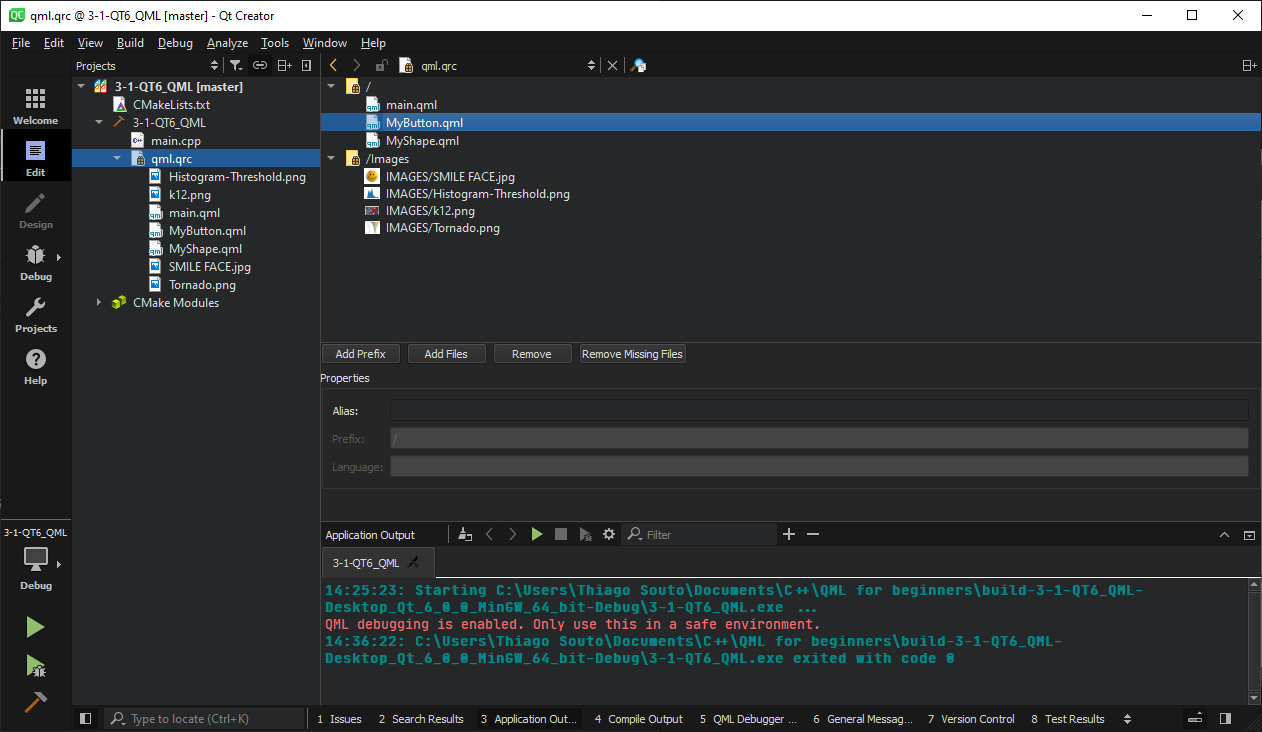
Now we create a new component called HoverButton
TIP
the alias type points to a child inside the stack that is being built.
Property alias basically points to another component, so they have all the properties for that component.
You use the alias property if you want to expose the child object, without having to make a property that points to every property of that child.
import QtQuick 2.0
Item {
id: root
property color color: "red"
property color hoverColor: "pink"
property color clickColor: "orange"
property color textColor: "White"
property color textHover: "Black"
property alias title: display
property alias area: mousearea
Rectangle {
height: root.height
width: root.width
color: root.color
clip: true
Text {
id: display
text: ""
anchors.centerIn: parent
color: root.textColor
font.bold: true
}
MouseArea {
id: mousearea
anchors.fill: parent
hoverEnabled: true
onEntered: {
parent.color = root.hoverColor
display.color = root.textHover
}
onExited: {
parent.color = root.color
display.color = root.textColor
}
onPressed: parent.color = root.clickColor
onReleased: parent.color = root.hoverColor
}
}
}
2
3
4
5
6
7
8
9
10
11
12
13
14
15
16
17
18
19
20
21
22
23
24
25
26
27
28
29
30
31
32
33
34
35
36
37
38
39
40
41
42
43
44
45
46
main.qml
import QtQuick 2.12
import QtQuick.Window 2.12
Window {
width: 640
height: 480
visible: true
title: qsTr("Image Viewer")
id: root
property color bgcolor: "#5A6263"
property color buttoncolor: "green"
property color hovercolor: "limegreen"
property color clickcolor: "yellow"
property var size: 100
Rectangle {
id: background
color: root.buttoncolor
width: 100
height: parent.height
Column {
id: column
anchors.fill: parent
HoverButton {
width: 100
height: 50
title.text: "Tornado"
color: root.buttoncolor
hoverColor: root.hovercolor
clickColor: root.clickcolor
area.onPressed: image.source = "qrc:/Images/IMAGES/Tornado.png"
}
HoverButton {
width: 100
height: 50
title.text: "Apples"
color: root.buttoncolor
hoverColor: root.hovercolor
clickColor: root.clickcolor
area.onPressed: image.source = "qrc:/Images/IMAGES/k12.png"
}
HoverButton {
width: 100
height: 50
title.text: "Histogram"
color: root.buttoncolor
hoverColor: root.hovercolor
clickColor: root.clickcolor
area.onPressed: image.source = "qrc:/Images/IMAGES/Histogram-Threshold.png"
}
}
}
Rectangle {
id: rectangle
color: root.bgcolor
x: 100
y: 0
width: parent.width - x
height: parent.height
Image {
id: image
anchors.margins: 25
anchors.fill: parent
fillMode: Image.PreserveAspectFit
source: "qrc:/Images/IMAGES/SMILE FACE.jpg"
}
}
}
2
3
4
5
6
7
8
9
10
11
12
13
14
15
16
17
18
19
20
21
22
23
24
25
26
27
28
29
30
31
32
33
34
35
36
37
38
39
40
41
42
43
44
45
46
47
48
49
50
51
52
53
54
55
56
57
58
59
60
61
62
63
64
65
66
67
68
69
70
71
72
73
74
75
76
77
78
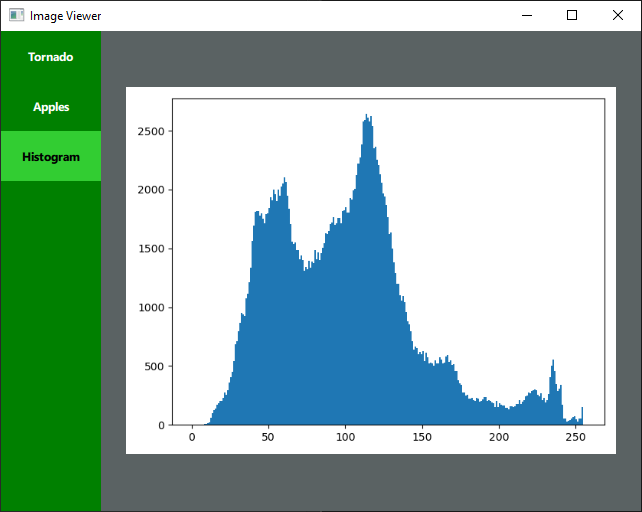
Adding a home button:
import QtQuick 2.12
import QtQuick.Window 2.12
Window {
width: 640
height: 480
visible: true
title: qsTr("Image Viewer")
id: root
property color bgcolor: "#5A6263"
property color buttoncolor: "green"
property color hovercolor: "limegreen"
property color clickcolor: "yellow"
property var size: 100
Rectangle {
id: background
color: root.buttoncolor
width: 100
height: parent.height
HoverButton {
width: 100
height: 50
title.text: "Home"
color: root.buttoncolor
hoverColor: root.hovercolor
clickColor: root.clickcolor
area.onPressed: image.source = "qrc:/IMAGES/qml.png"
anchors.bottom: background.bottom
}
Column {
id: column
anchors.fill: parent
HoverButton {
width: 100
height: 50
title.text: "Tornado"
color: root.buttoncolor
hoverColor: root.hovercolor
clickColor: root.clickcolor
area.onPressed: image.source = "qrc:/Images/IMAGES/Tornado.png"
}
HoverButton {
width: 100
height: 50
title.text: "Apples"
color: root.buttoncolor
hoverColor: root.hovercolor
clickColor: root.clickcolor
area.onPressed: image.source = "qrc:/Images/IMAGES/k12.png"
}
HoverButton {
width: 100
height: 50
title.text: "Histogram"
color: root.buttoncolor
hoverColor: root.hovercolor
clickColor: root.clickcolor
area.onPressed: image.source = "qrc:/Images/IMAGES/Histogram-Threshold.png"
}
}
}
Rectangle {
id: rectangle
color: root.bgcolor
x: 100
y: 0
width: parent.width - x
height: parent.height
Image {
id: image
anchors.margins: 25
anchors.fill: parent
fillMode: Image.PreserveAspectFit
source: "qrc:/IMAGES/qml.png"
}
}
}
2
3
4
5
6
7
8
9
10
11
12
13
14
15
16
17
18
19
20
21
22
23
24
25
26
27
28
29
30
31
32
33
34
35
36
37
38
39
40
41
42
43
44
45
46
47
48
49
50
51
52
53
54
55
56
57
58
59
60
61
62
63
64
65
66
67
68
69
70
71
72
73
74
75
76
77
78
79
80
81
82
83
84
85
86
87
88
89
90
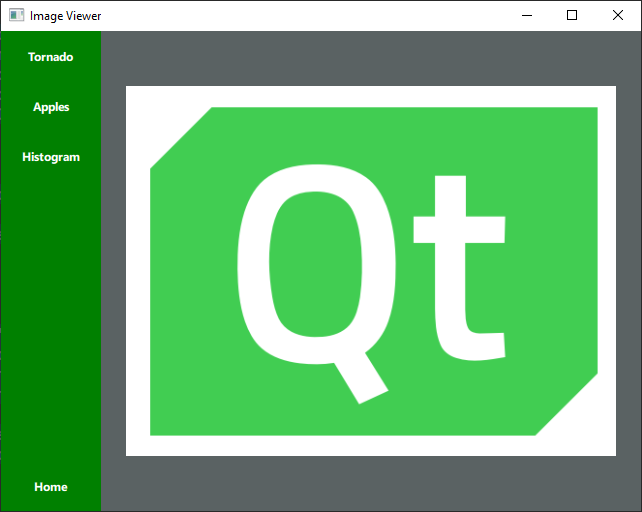
# Section 6 - Properties and animations
# Property and PropertyAnimation
Animating a square to cross the screen:
import QtQuick 2.12
import QtQuick.Window 2.12
Window {
width: 640
height: 480
visible: true
title: qsTr("Image Viewer")
id: root
Rectangle {
id: myShape
color: "red"
width: 100
height: 100
x: 0
y: (parent.height / 2) - (height / 2)
PropertyAnimation {
id: animationRight
target: myShape
property: "x"
to: root.width - myShape.width
duration: 500
}
PropertyAnimation {
id: animationLeft
target: myShape
property: "x"
to: 0
duration: 500
}
MouseArea {
anchors.fill: parent
onClicked: {
if(myShape.x === 0) {
animationRight.start()
} else animationLeft.start()
}
}
}
}
2
3
4
5
6
7
8
9
10
11
12
13
14
15
16
17
18
19
20
21
22
23
24
25
26
27
28
29
30
31
32
33
34
35
36
37
38
39
40
41
42
43
44
# Rotation and RotationAnimation
import QtQuick 2.12
import QtQuick.Window 2.12
Window {
width: 640
height: 480
visible: true
title: qsTr("Image Viewer")
id: root
Rectangle {
id: myShape
color: "red"
width: 200
height: 200
anchors.centerIn: parent
Text {
id: title
text: Math.round(parent.rotation)
anchors.centerIn: parent
font.bold: true
font.pointSize: 65
}
RotationAnimation {
id:animation
target: myShape
loops: Animation.Infinite
from: myShape.rotation
to: 360 //-360 is BAD
direction: RotationAnimation.Clockwise
duration: 20000
running: true
}
}
}
2
3
4
5
6
7
8
9
10
11
12
13
14
15
16
17
18
19
20
21
22
23
24
25
26
27
28
29
30
31
32
33
34
35
36
37
TIP
The use of id like in myShape.rotation could be a problem if there is any spelling mistake. Be Aware.
Including a mouse area so we can pause the animation with a click:
import QtQuick 2.12
import QtQuick.Window 2.12
Window {
width: 640
height: 480
visible: true
title: qsTr("Image Viewer")
id: root
Rectangle {
id: myShape
color: "red"
width: 200
height: 200
anchors.centerIn: parent
Text {
id: title
text: Math.round(parent.rotation)
anchors.centerIn: parent
font.bold: true
font.pointSize: 65
}
RotationAnimation {
id:animation
target: myShape
loops: Animation.Infinite
from: myShape.rotation
to: 360 //-360 is BAD
direction: RotationAnimation.Clockwise
duration: 20000
running: true
}
MouseArea {
id: area
anchors.fill: parent
onClicked: {
if (animation.paused) {
animation.resume()
} else {
animation.pause()
}
}
}
}
}
2
3
4
5
6
7
8
9
10
11
12
13
14
15
16
17
18
19
20
21
22
23
24
25
26
27
28
29
30
31
32
33
34
35
36
37
38
39
40
41
42
43
44
45
46
47
48
49
TIP
animation.paused returns a boolean saying if the animation was paused, and animation.pause() apuses the animation
# Scale and SequentialAnimation
Now using a sequential animation we are going to scale up the rectangle and scale down in a sequence. We are also cliping the text to the rectangle.
import QtQuick 2.12
import QtQuick.Window 2.12
Window {
width: 640
height: 480
visible: true
title: qsTr("Image Viewer")
id: root
Rectangle {
id: myShape
color: "red"
width: 200
height: 200
anchors.centerIn: parent
clip: true
Text {
id: title
text: qsTr("SCALE")
font.bold: true
font.pointSize: 67
rotation: -45
anchors.centerIn: parent
}
SequentialAnimation {
id: animation
running: true
loops: Animation.Infinite
ScaleAnimator {
id: aniShrink
target: myShape
from: 1
to: 0.5
duration: 2000
running: true
}
ScaleAnimator {
id: aniGrow
target: myShape
from: 0.5
to: 1
duration: 2000
running: true
}
}
}
}
2
3
4
5
6
7
8
9
10
11
12
13
14
15
16
17
18
19
20
21
22
23
24
25
26
27
28
29
30
31
32
33
34
35
36
37
38
39
40
41
42
43
44
45
46
47
48
49
50
51
52
# Opacity and OpacityAnimator
For the opacity example we are going to change the windows backgroung to black so we can have the desired effect and set an opacity animation.
import QtQuick 2.12
import QtQuick.Window 2.12
Window {
width: 640
height: 480
visible: true
title: qsTr("Image Viewer")
id: root
color: "black"
Image {
id: ghost
source: "qrc:/IMAGES/Ghost.jfif"
anchors.fill: parent
opacity: 0
}
SequentialAnimation {
loops: Animation.Infinite
running: true
OpacityAnimator {
target: ghost
from: 0
to: 1
duration: 500
}
OpacityAnimator {
target: ghost
from: 1
to: 0
duration: 3000
}
}
}
2
3
4
5
6
7
8
9
10
11
12
13
14
15
16
17
18
19
20
21
22
23
24
25
26
27
28
29
30
31
32
33
34
35
36
37
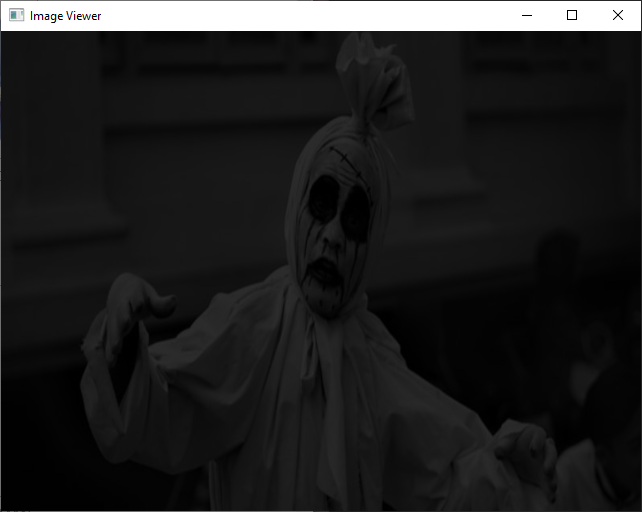
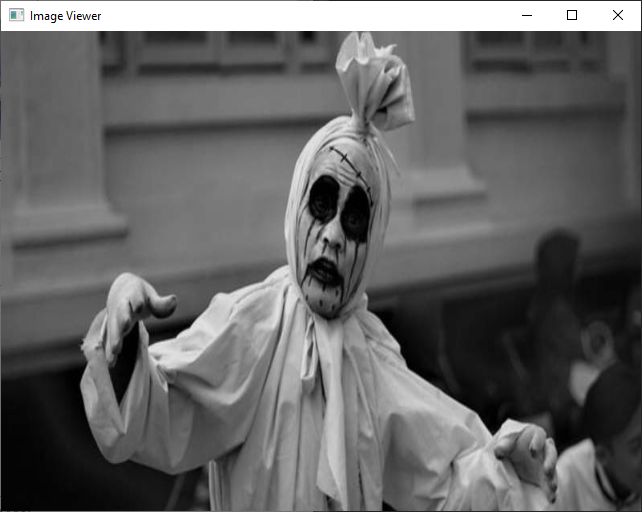
# SmoothedAnimation
import QtQuick 2.15
import QtQuick.Window 2.15
Window {
visible: true
width: 640
height: 480
title: qsTr("Animation test")
Rectangle {
anchors.fill: parent
color: "black"
focus: true
Rectangle {
width: 60
height: 60
color: "yellow"
radius: width
x: rect1.x -5
y: rect1.y -5
Behavior on x { SmoothedAnimation {velocity: 100}}
Behavior on y { SmoothedAnimation {velocity: 100}}
}
Rectangle {
id:rect1
width: 50
height: 50
color: "red"
radius: width
x: (parent.width/2) - (width/2)
y: (parent.height/2) - (height/2)
}
Keys.onRightPressed: rect1.x = rect1.x + 100
Keys.onLeftPressed: rect1.x = rect1.x - 100
Keys.onUpPressed: rect1.y = rect1.y - 100
Keys.onDownPressed: rect1.y = rect1.y + 100
}
}
2
3
4
5
6
7
8
9
10
11
12
13
14
15
16
17
18
19
20
21
22
23
24
25
26
27
28
29
30
31
32
33
34
35
36
37
38
39
40
41
42
43
44
TIP
focus: true, basically means that if you hit the keyboard this item will be affected because it is in focus.
# Anti-aliasing
Anti-aliasing is turned on by default, but you can turn it off.
import QtQuick 2.15
import QtQuick.Window 2.15
Window {
visible: true
width: 640
height: 480
title: qsTr("Animation test")
Row {
anchors.centerIn: parent
spacing: 20
Rectangle {
width: 200
height: 200
border.color: "red"
border.width: 20
radius: width
Text {
anchors.centerIn: parent
text: qsTr("Turned On")
}
}
Rectangle {
width: 200
height: 200
border.color: "red"
border.width: 20
radius: width
antialiasing: false
Text {
anchors.centerIn: parent
text: qsTr("Turned Off")
}
}
}
}
2
3
4
5
6
7
8
9
10
11
12
13
14
15
16
17
18
19
20
21
22
23
24
25
26
27
28
29
30
31
32
33
34
35
36
37
38
39
40
41
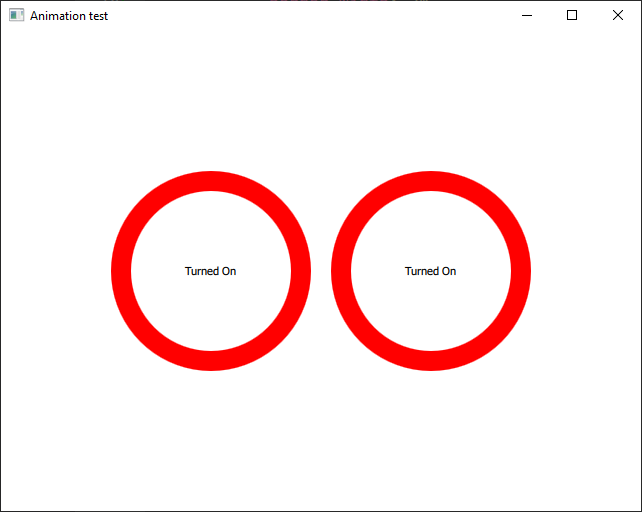
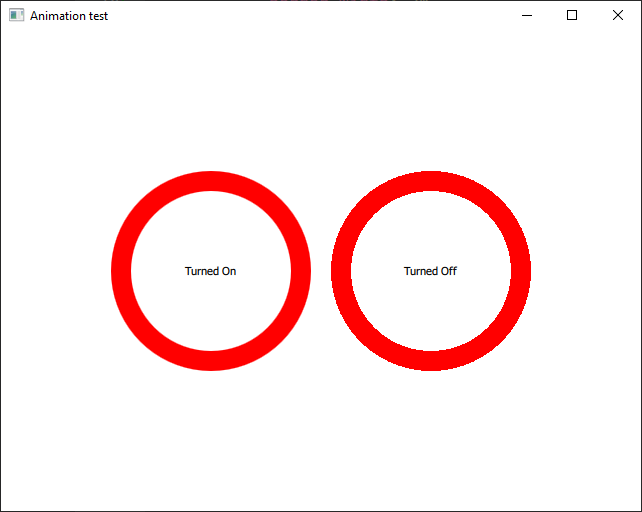
# Keyboard input
In this example we are going to control the width and height of the red rectangle.
import QtQuick 2.15
import QtQuick.Window 2.15
Window {
visible: true
width: 640
height: 480
title: qsTr("Animation test")
Rectangle {
id: background
anchors.fill: parent
color: "black"
focus: true
Rectangle {
id: rect1
anchors.centerIn: parent
width: 100
height: 100
color: "red"
}
Rectangle {
id: outline
anchors.centerIn: parent
width: 100
height: 100
color: "transparent"
border.color: "yellow"
border.width: 5
}
Keys.onUpPressed: rect1.height += 10
Keys.onDownPressed: rect1.height -= 10
Keys.onLeftPressed: rect1.width += 10
Keys.onRightPressed: rect1.width -= 10
}
}
2
3
4
5
6
7
8
9
10
11
12
13
14
15
16
17
18
19
20
21
22
23
24
25
26
27
28
29
30
31
32
33
34
35
36
37
38
39
# Transform and Translate
You can anchor something and using transform translate move it on an offset based on its anchor.
kind of has this dizzying effect because this yellow one is not pixel perfect right to the center where
the blue and red are but it really outlines the power of this.
import QtQuick 2.15
import QtQuick.Window 2.15
Window {
visible: true
width: 640
height: 480
title: qsTr("Animation test")
Item {
id: root
rotation: 0
anchors.centerIn: parent
Rectangle {
id: yellowRect
color: "yellow"
width: 300
height: 300
radius: width
opacity: 0.5
border.width: 2
border.color: "black"
anchors.centerIn: parent
transform: Translate {y: -100}
}
Rectangle {
id: blueRect
color: "blue"
width: 300
height: 300
radius: width
opacity: 0.5
border.width: 2
border.color: "black"
anchors.centerIn: parent
transform: Translate {y: 100; x: -100}
}
Rectangle {
id: redRect
color: "red"
width: 300
height: 300
radius: width
opacity: 0.5
border.width: 2
border.color: "black"
anchors.centerIn: parent
transform: Translate {y: 100; x: 100}
}
Rectangle {
id: centerArea
color: "white"
width: 50
height: 50
radius: width
opacity: 1
border.width: 2
border.color: "black"
anchors.centerIn: parent
Rectangle {
id: centerCircle
color: "gray"
width: 5
height: 5
radius: width
opacity: 1
border.width: 2
border.color: "black"
anchors.centerIn: parent
}
}
RotationAnimator {
target: root
from: 360
to: 0
duration: 5000
direction: RotationAnimator.Counterclockwise
loops: Animation.Infinite
running: true
}
}
}
2
3
4
5
6
7
8
9
10
11
12
13
14
15
16
17
18
19
20
21
22
23
24
25
26
27
28
29
30
31
32
33
34
35
36
37
38
39
40
41
42
43
44
45
46
47
48
49
50
51
52
53
54
55
56
57
58
59
60
61
62
63
64
65
66
67
68
69
70
71
72
73
74
75
76
77
78
79
80
81
82
83
84
85
86
87
88
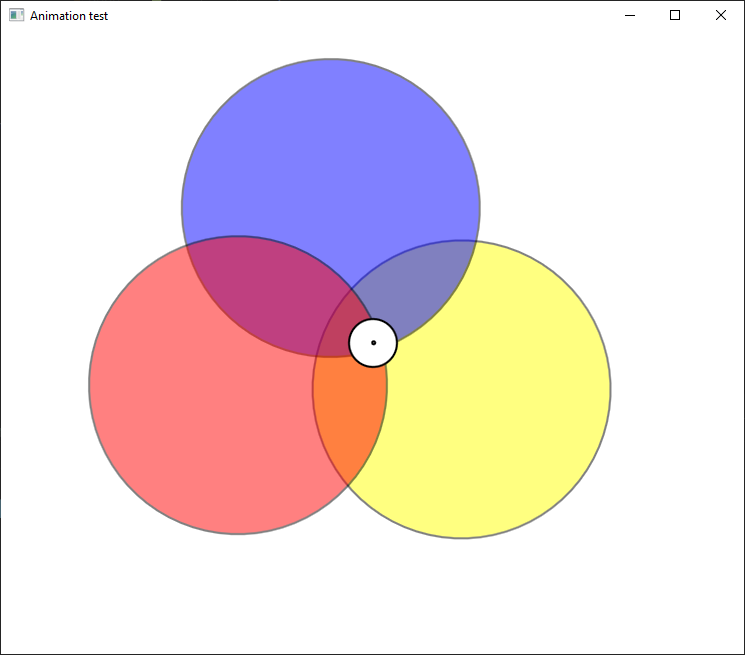
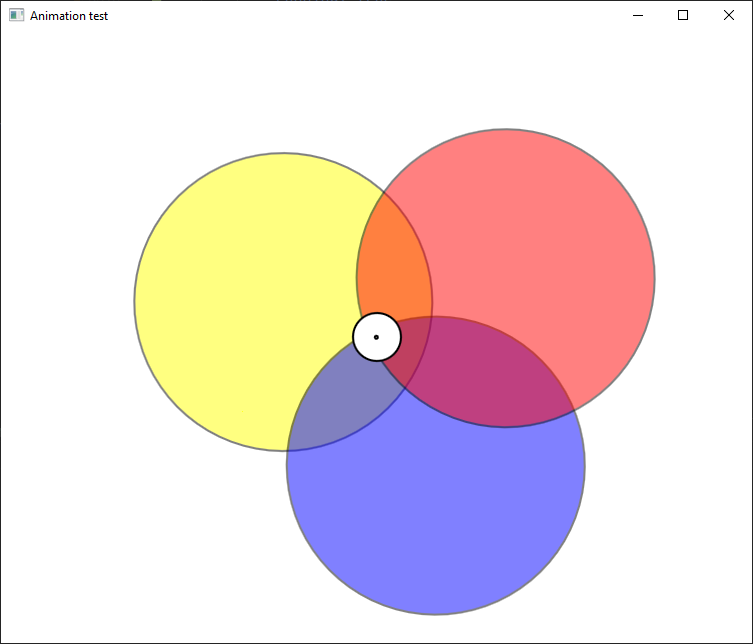
# Drag and drop
import QtQuick 2.15
import QtQuick.Window 2.15
Window {
id: root
visible: true
width: 640
height: 480
title: qsTr("QML rules")
property string thekey: "special key here"
property color goalOn: "green"
property color goalOff: "red"
property color ballOn: "yellow"
property color ballOff: "orange"
DropArea {
id: dropZone
anchors.top: parent.top
anchors.right: parent.right
anchors.bottom: parent.bottom
width: 300
Drag.keys: [thekey]
onDropped: {
console.log("dropped!!!")
goal.color = goalOn
}
Rectangle {
id: goal
anchors.fill: parent
color: goalOff
border.color: "black"
border.width: 5
}
}
Rectangle {
id: ball
width: 100
height: 100
radius: width
x: 25
y: (parent.height / 2) - (height / 2)
color: ballOff
border.color: "black"
border.width: 5
Drag.active: dragArea.drag.active
Drag.keys: [thekey]
Text {
id: title
anchors.centerIn: parent
text: Math.round(parent.x) + " x " + Math.round(parent.y)
}
MouseArea {
id: dragArea
anchors.fill: parent
drag.target: parent
onPressed: {parent.color = ballOn; goal.color= goalOff}
onReleased: {parent.color = ballOff; parent.Drag.drop()}
}
}
}
2
3
4
5
6
7
8
9
10
11
12
13
14
15
16
17
18
19
20
21
22
23
24
25
26
27
28
29
30
31
32
33
34
35
36
37
38
39
40
41
42
43
44
45
46
47
48
49
50
51
52
53
54
55
56
57
58
59
60
61
62
63
64
65
66
67
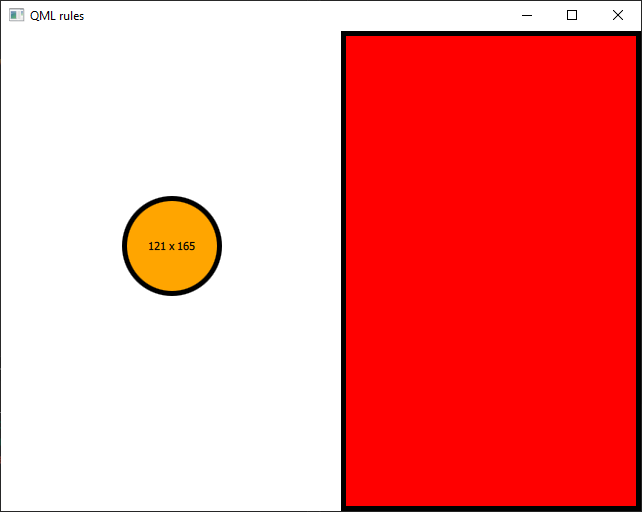
# Qt Designer
# Connections
onClicked is a bit misleading, because you have to have a mouse area on the object to be able to click. If you click on rectangle and add a connection onClicked, nothing happens.
import QtQuick 2.15
import QtQuick.Window 2.15
Window {
id: root
visible: true
width: 640
height: 480
title: qsTr("QML rules")
Rectangle {
id: rectangle
x: 125
y: 92
width: 100
height: 100
color: "#d80101"
MouseArea {
id: mouseArea
anchors.fill: parent
Connections {
target: mouseArea
onClicked: console.log("clicked")
}
}
}
Rectangle {
id: rectangle1
x: 270
y: 92
width: 100
height: 100
color: "#00dd0f"
}
Rectangle {
id: rectangle2
x: 413
y: 92
width: 100
height: 100
color: "#0212e4"
}
}
/*##^##
Designer {
D{i:0;formeditorZoom:0.6600000262260437}D{i:2}
}
##^##*/
2
3
4
5
6
7
8
9
10
11
12
13
14
15
16
17
18
19
20
21
22
23
24
25
26
27
28
29
30
31
32
33
34
35
36
37
38
39
40
41
42
43
44
45
46
47
48
49
50
51
52
53
54
55
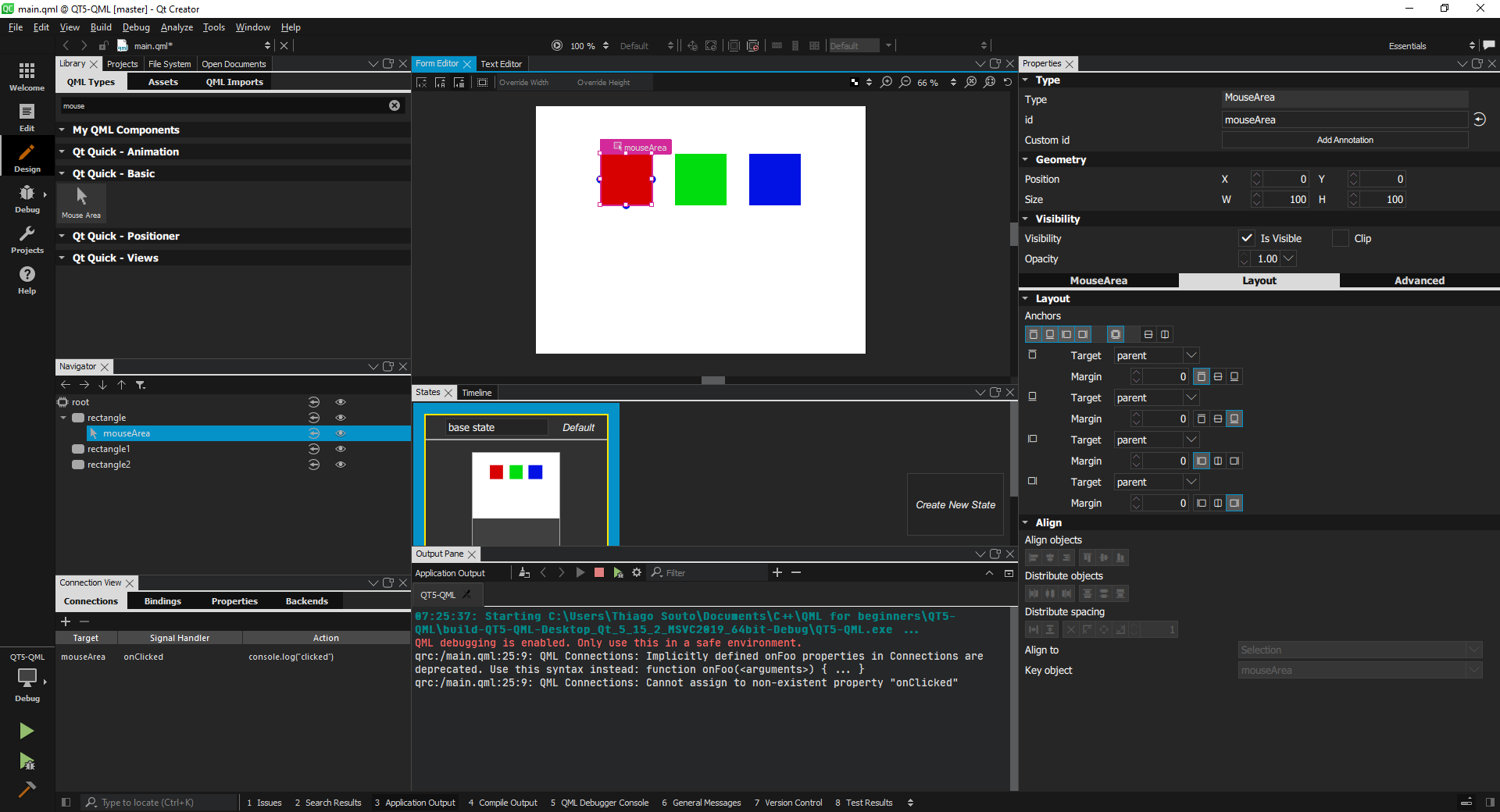
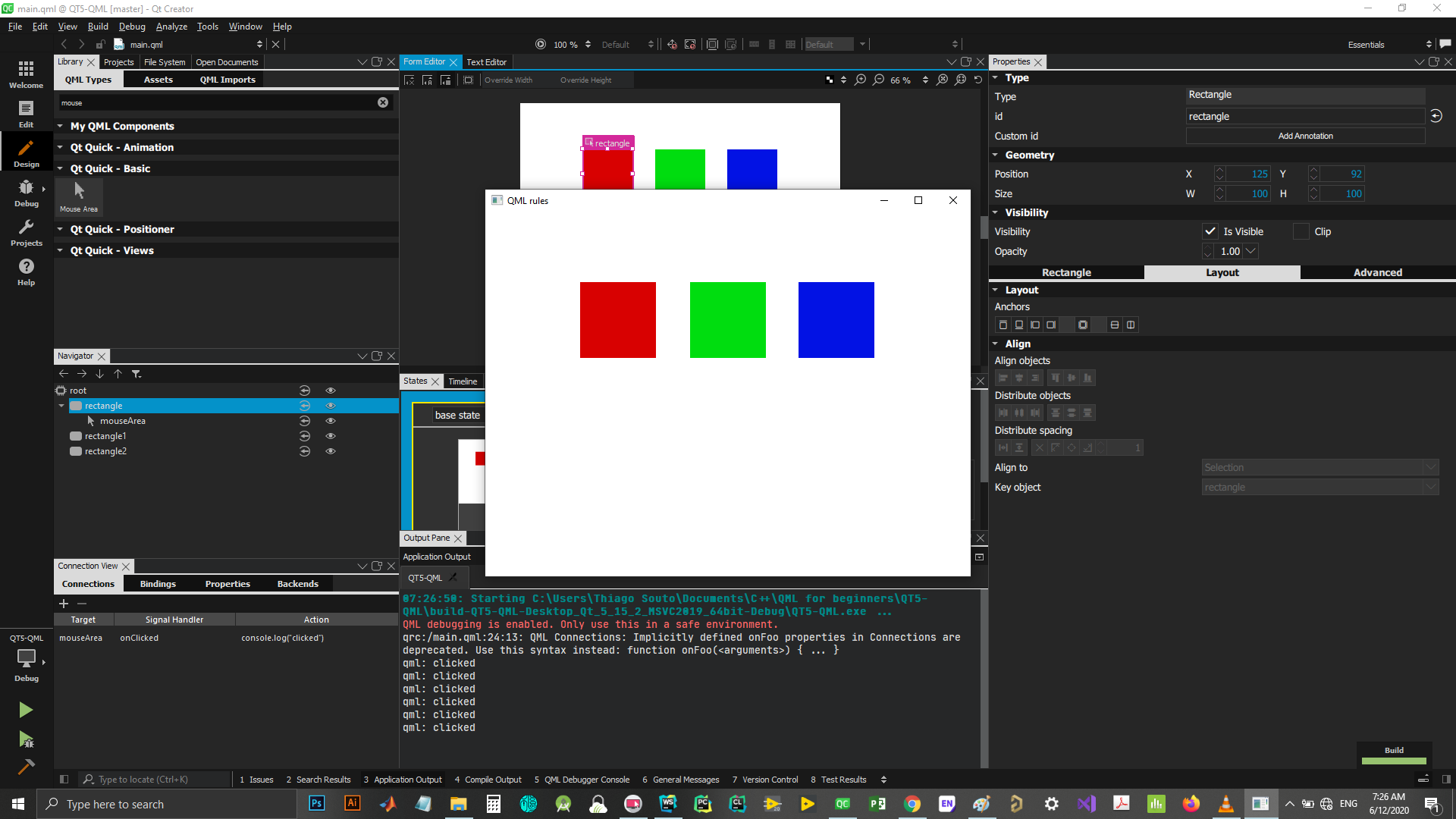
# Bindings
We can also set bindings between the objects:
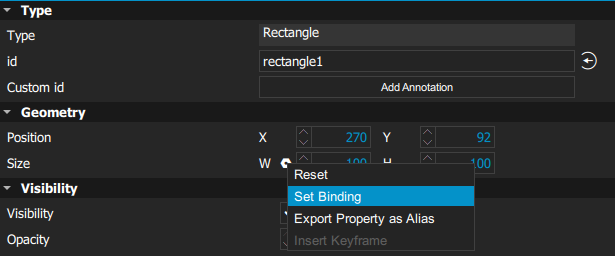
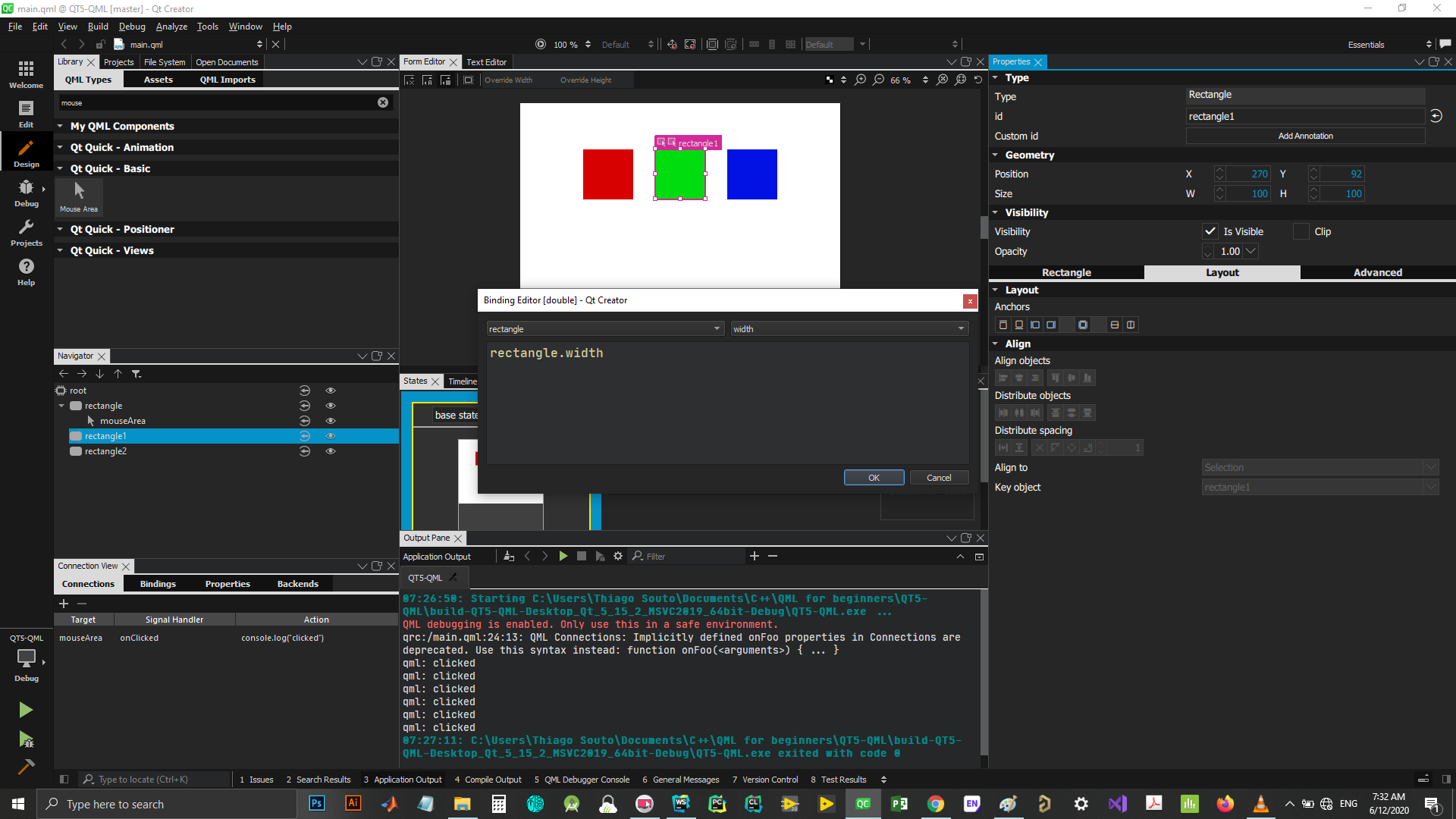
Now to test the binding lets make the mouse click change the width and height.
import QtQuick 2.15
import QtQuick.Window 2.15
Window {
id: root
visible: true
width: 640
height: 480
title: qsTr("QML rules")
Rectangle {
id: rectangle
x: 125
y: 92
width: 100
height: 100
color: "#d80101"
MouseArea {
id: mouseArea
anchors.fill: parent
Connections {
target: mouseArea
onClicked: {
print("clicked")
rectangle.width= 50
rectangle.height= 150
}
}
}
}
Rectangle {
id: rectangle1
x: 270
y: 92
width: rectangle.width
height: rectangle.height
color: "#00dd0f"
}
Rectangle {
id: rectangle2
x: 413
y: 92
width: 100
height: 100
color: "#0212e4"
}
}
/*##^##
Designer {
D{i:0;formeditorZoom:0.6600000262260437}D{i:2}
}
##^##*/
2
3
4
5
6
7
8
9
10
11
12
13
14
15
16
17
18
19
20
21
22
23
24
25
26
27
28
29
30
31
32
33
34
35
36
37
38
39
40
41
42
43
44
45
46
47
48
49
50
51
52
53
54
55
56
57
58
59
Now Let's make two rectangles and a text to one and make it change when the other one is clicked.
import QtQuick 2.15
import QtQuick.Window 2.15
Window {
id: root
visible: true
width: 640
height: 480
title: qsTr("QML rules")
Rectangle {
id: rectangle
x: 102
y: 151
width: 200
height: 200
color: "#2f04ea"
MouseArea {
id: mouseArea
anchors.fill: parent
Connections {
target: mouseArea
onClicked: text1.text = "Hello"
}
}
}
Rectangle {
id: rectangle1
x: 347
y: 151
width: 200
height: 200
color: "#118013"
Text {
id: text1
color: "#ffffff"
text: qsTr("Text")
anchors.verticalCenter: parent.verticalCenter
font.pixelSize: 35
font.bold: true
anchors.horizontalCenter: parent.horizontalCenter
}
}
}
/*##^##
Designer {
D{i:0;formeditorZoom:0.6600000262260437}D{i:2}
}
##^##*/
2
3
4
5
6
7
8
9
10
11
12
13
14
15
16
17
18
19
20
21
22
23
24
25
26
27
28
29
30
31
32
33
34
35
36
37
38
39
40
41
42
43
44
45
46
47
48
49
50
51
52
53
54
55
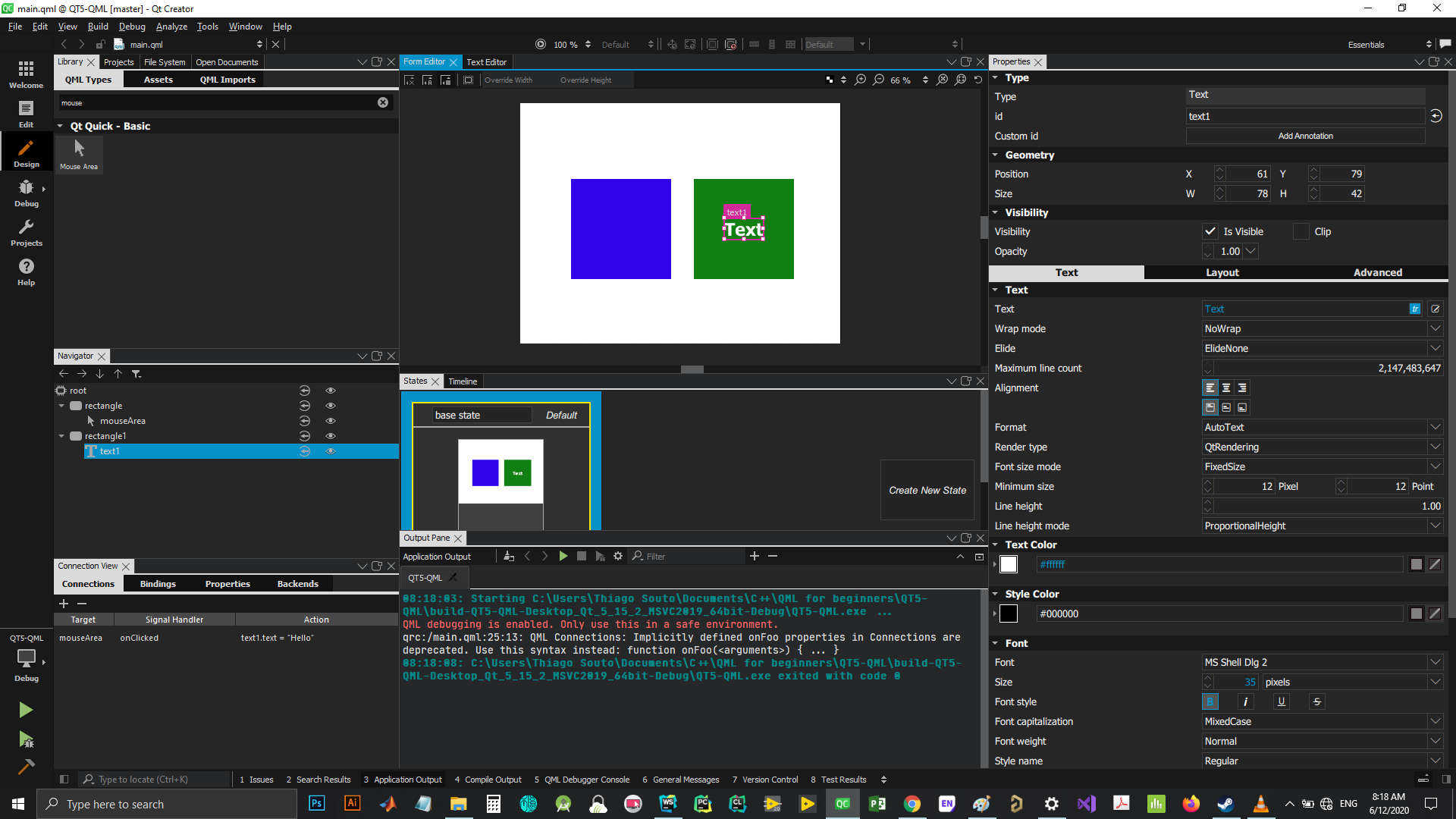
TIP
Remember that we have to add a mouse area and add the connection to the mouse area and not the rectangle.
# Properties
We can also add properties to the objects, like a title for instance; and it will appear on the qml code.
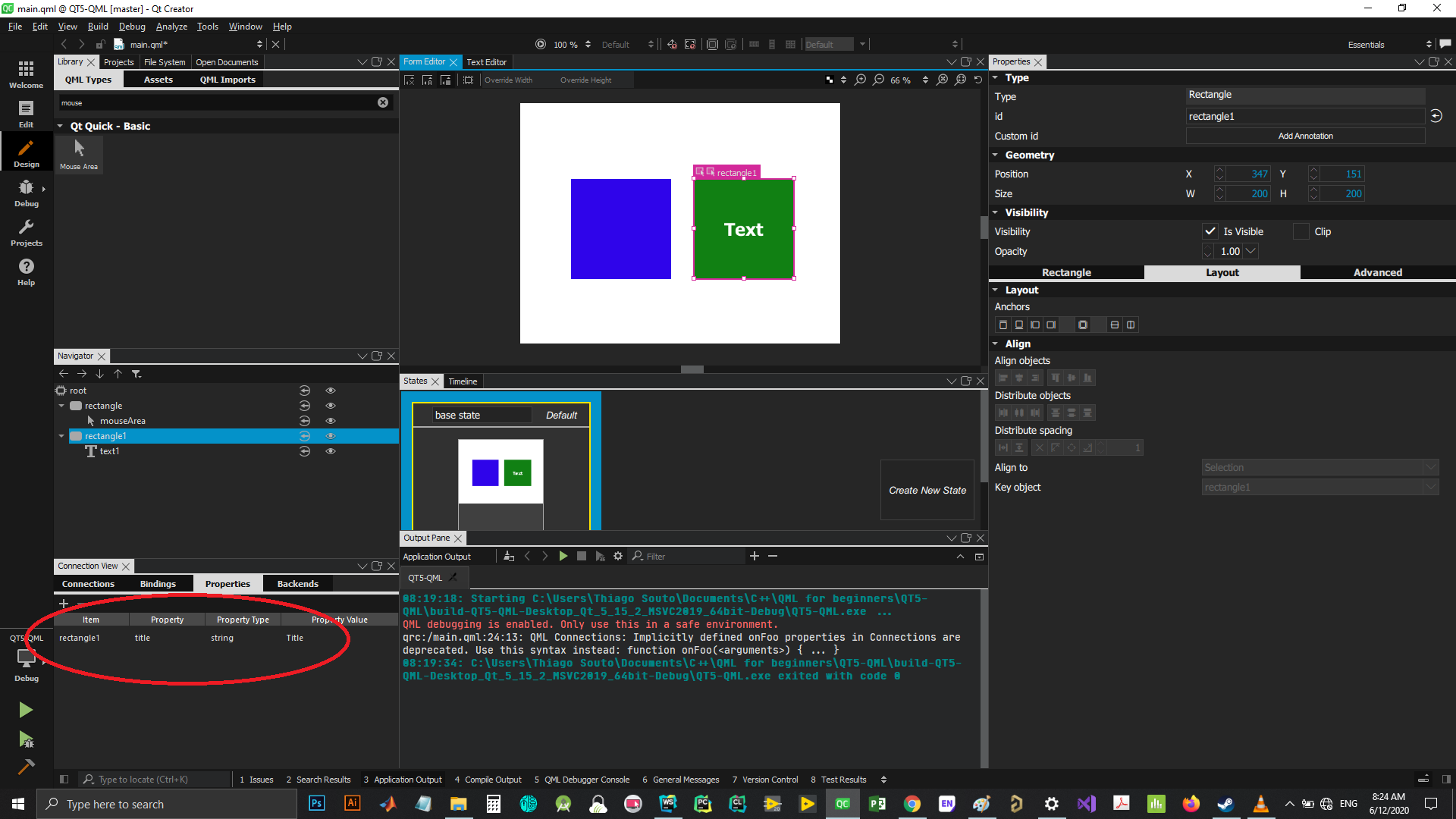
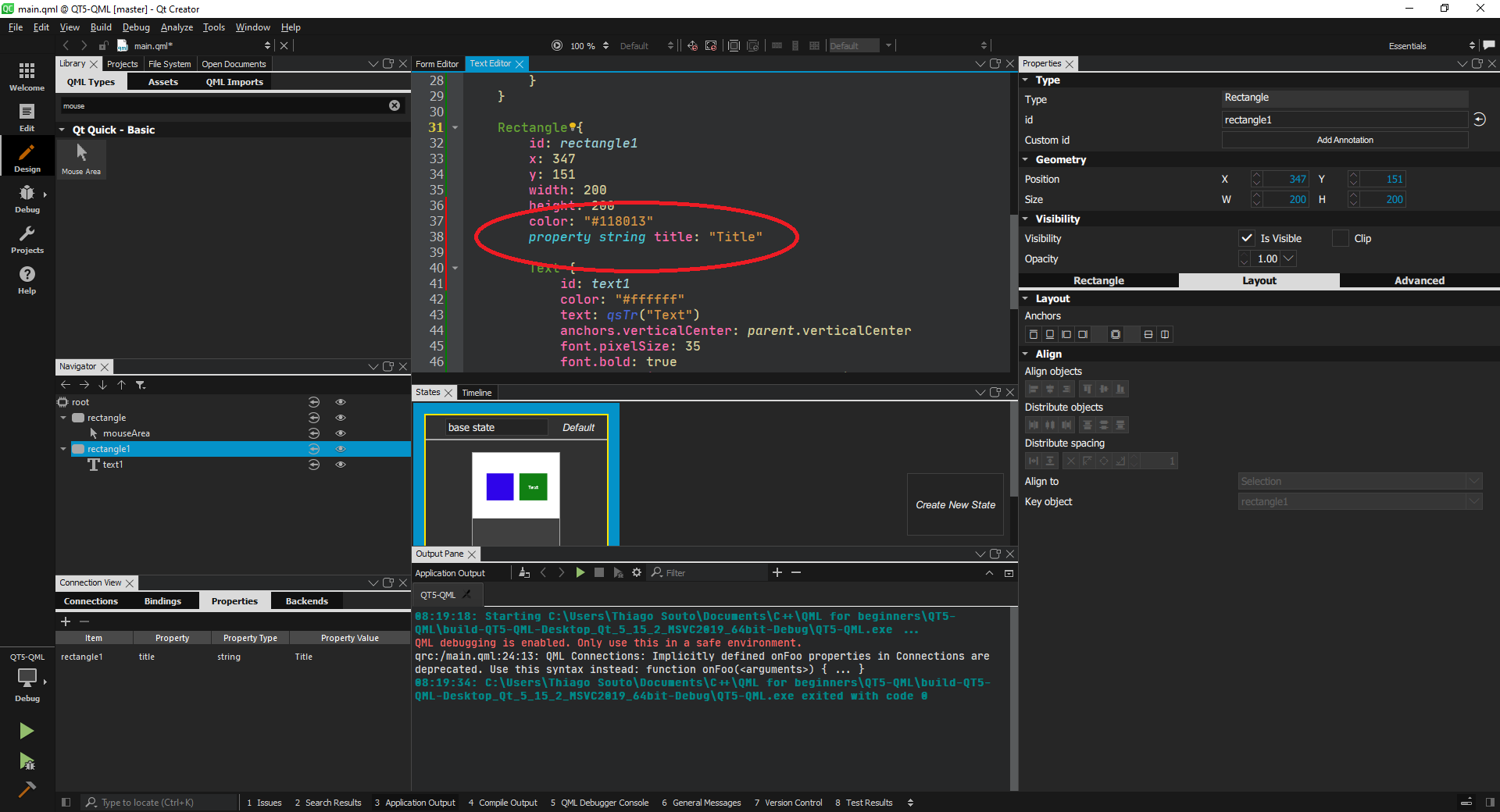
Now we can bind the title property to the text.
import QtQuick 2.15
import QtQuick.Window 2.15
Window {
id: root
visible: true
width: 640
height: 480
title: qsTr("QML rules")
Rectangle {
id: rectangle
x: 102
y: 151
width: 200
height: 200
color: "#2f04ea"
MouseArea {
id: mouseArea
anchors.fill: parent
Connections {
target: mouseArea
onClicked: rectangle1.title = "Hello"
}
}
}
Rectangle {
id: rectangle1
x: 347
y: 151
width: 200
height: 200
color: "#118013"
property string title: "Title"
Text {
id: text1
color: "#ffffff"
text: parent.title
anchors.verticalCenter: parent.verticalCenter
font.pixelSize: 35
font.bold: true
anchors.horizontalCenter: parent.horizontalCenter
}
}
}
/*##^##
Designer {
D{i:0;formeditorZoom:0.6600000262260437}D{i:2}
}
##^##*/
2
3
4
5
6
7
8
9
10
11
12
13
14
15
16
17
18
19
20
21
22
23
24
25
26
27
28
29
30
31
32
33
34
35
36
37
38
39
40
41
42
43
44
45
46
47
48
49
50
51
52
53
54
55
56
And it works the same way.
# States
First, let's create another qml file called MyBox and add some properties.
Also let's bind the color to the defaultColor propertie.
import QtQuick 2.0
Item {
id: element
property color offColor: "red"
property color onColor: "green"
property color defaultColor: "gray"
Rectangle {
id: rectangle
x: 220
y: 140
width: 200
height: 200
color: defaultColor
}
}
2
3
4
5
6
7
8
9
10
11
12
13
14
15
16
17
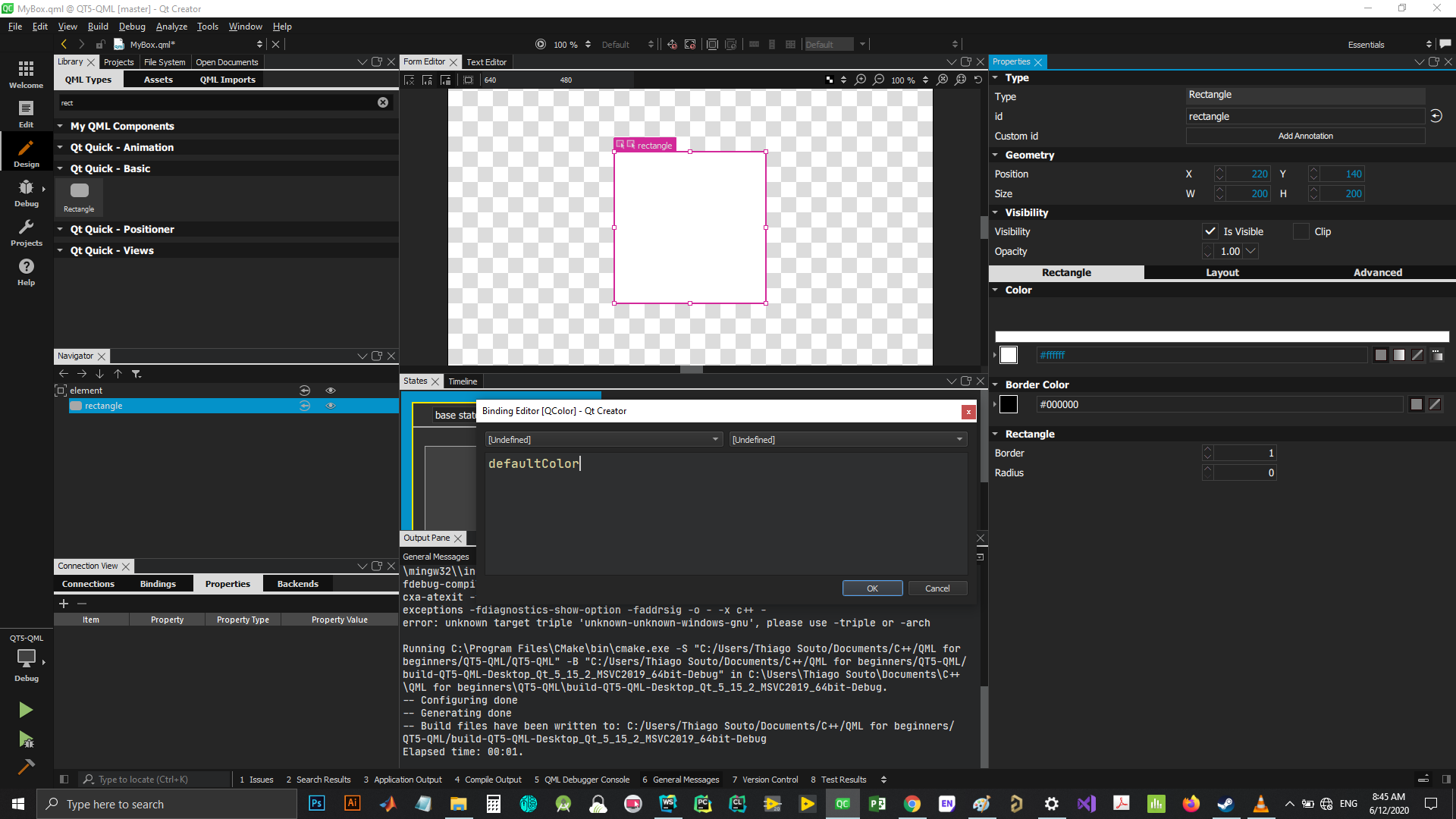
Now let's fill the rectangle to the item,make it round, and add a state.
import QtQuick 2.0
Item {
id: element
property color offColor: "red"
property color onColor: "green"
property color defaultColor: "gray"
Rectangle {
id: rectangle
color: defaultColor
anchors.fill: parent
radius: width
}
}
/*##^##
Designer {
D{i:0;autoSize:true;height:480;width:640}D{i:1}
}
##^##*/
2
3
4
5
6
7
8
9
10
11
12
13
14
15
16
17
18
19
20
21
22
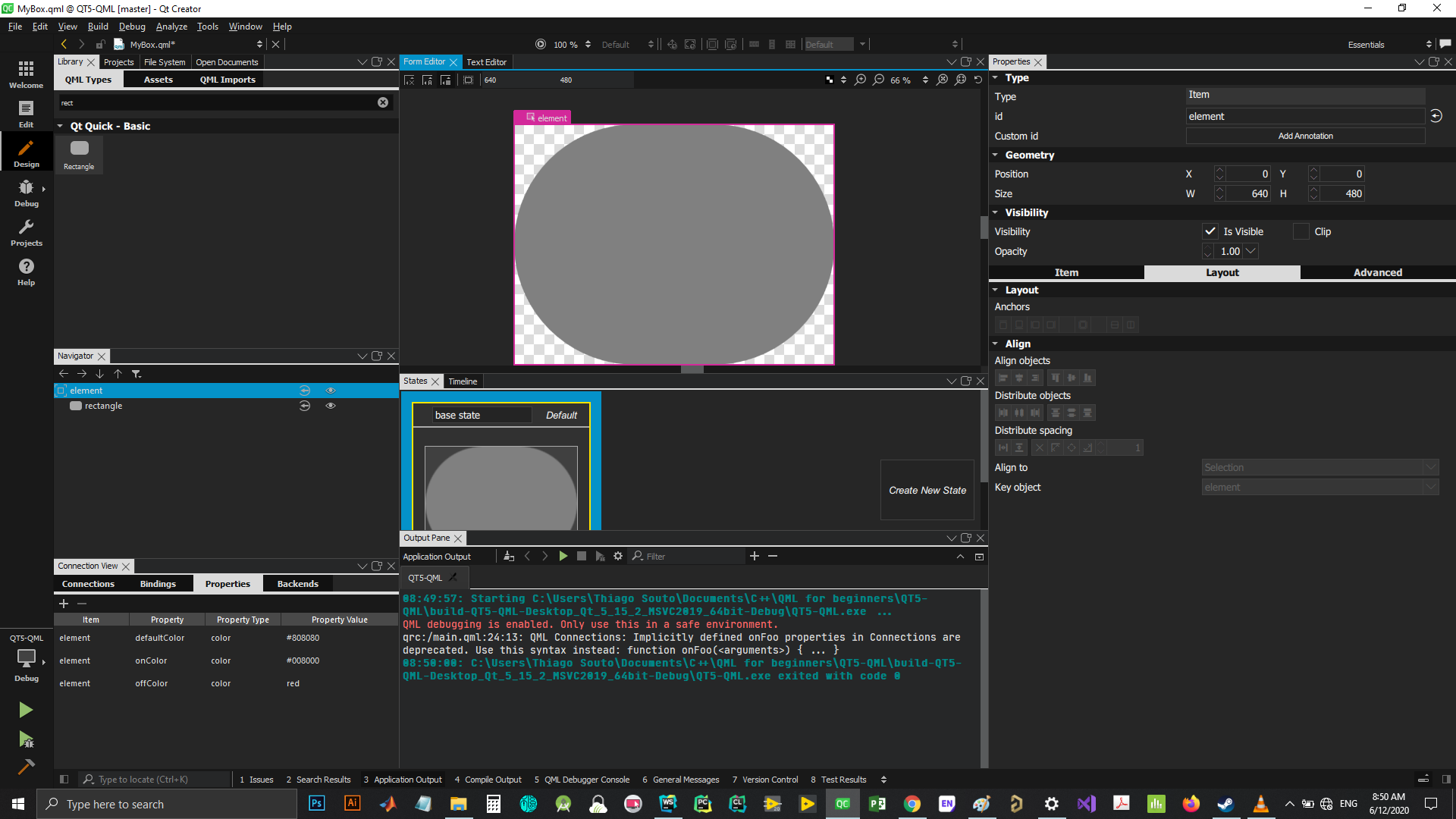
Now let's add some other states
import QtQuick 2.0
Item {
id: element
property color offColor: "red"
property color onColor: "green"
property color defaultColor: "gray"
Rectangle {
id: rectangle
color: defaultColor
anchors.fill: parent
radius: width
}
states: [
State {
name: "on"
PropertyChanges {
target: rectangle
color: onColor
}
},
State {
name: "off"
PropertyChanges {
target: rectangle
color: offColor
}
}
]
}
/*##^##
Designer {
D{i:0;autoSize:true;formeditorZoom:0.6600000262260437;height:480;width:640}D{i:1}
}
##^##*/
2
3
4
5
6
7
8
9
10
11
12
13
14
15
16
17
18
19
20
21
22
23
24
25
26
27
28
29
30
31
32
33
34
35
36
37
38
39
40
41
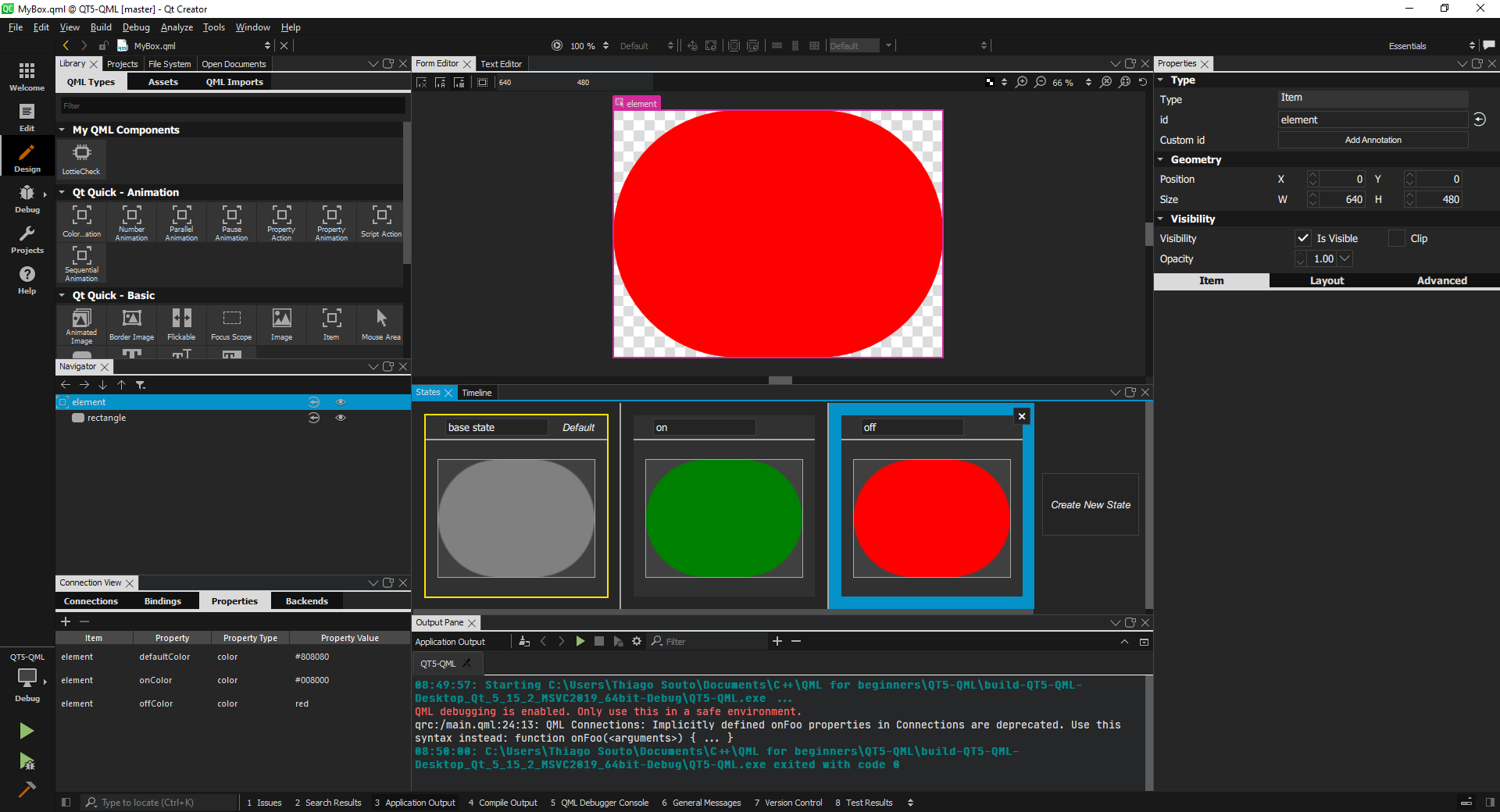
TIP
States cannot be added to a Window, has to be a custom object.
Now the item is on My QML Components, and we can drag and drop it. Although we have to give it a width and height, otherwise is will be only a point.
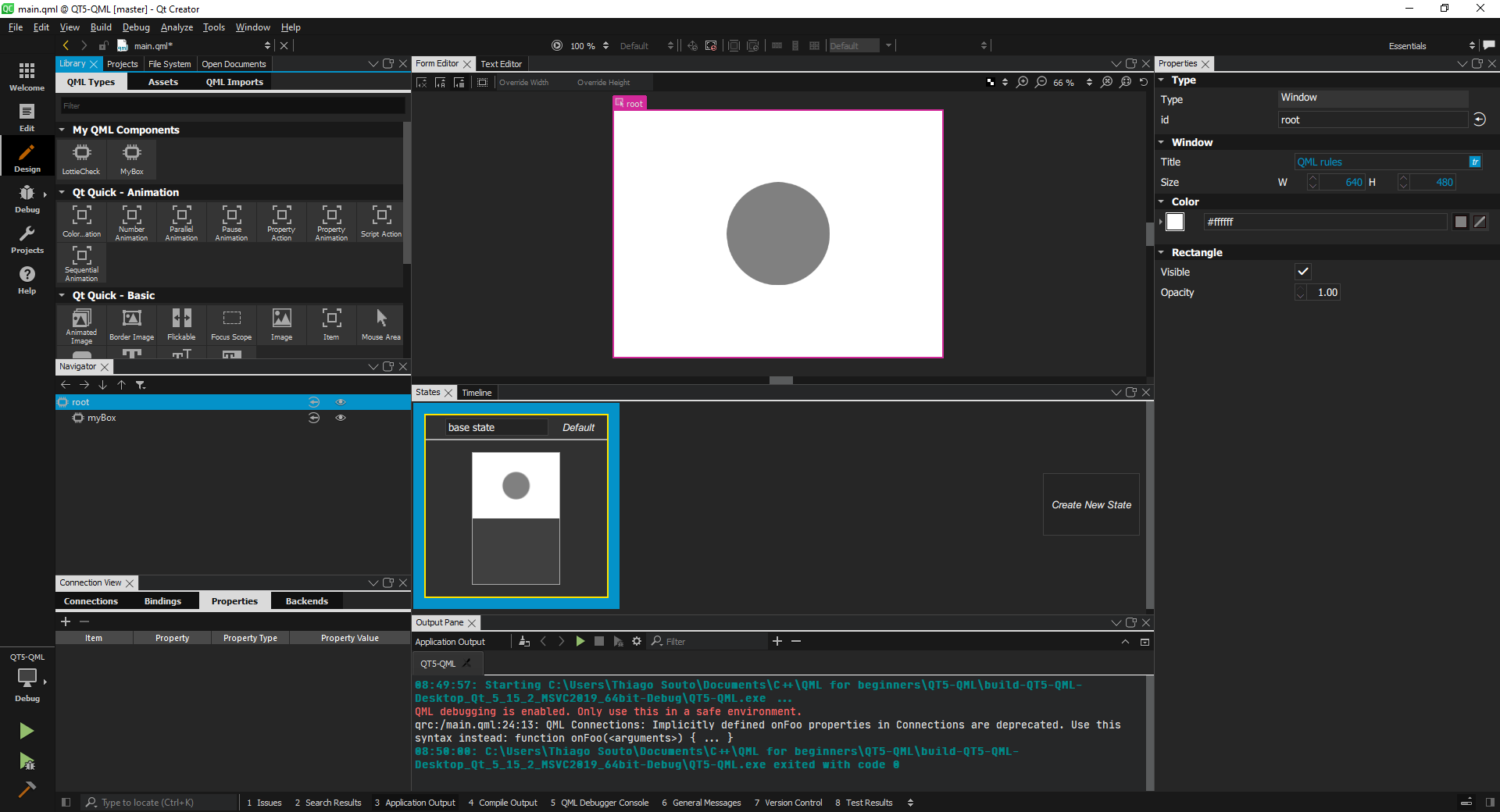
we can change the state by adding a connextion on the mouse area:
import QtQuick 2.15
import QtQuick.Window 2.15
Window {
id: root
visible: true
width: 640
height: 480
title: qsTr("QML rules")
MyBox {
id: myBox
x: 220
y: 140
width: 200
height: 200
MouseArea {
id: mouseArea
anchors.fill: parent
Connections {
target: mouseArea
onClicked: {
if(myBox.state === "on") {
myBox.state = "off"
} else {
myBox.state = "on"
}
}
}
}
}
}
/*##^##
Designer {
D{i:0;formeditorZoom:0.6600000262260437}D{i:2}
}
##^##*/
2
3
4
5
6
7
8
9
10
11
12
13
14
15
16
17
18
19
20
21
22
23
24
25
26
27
28
29
30
31
32
33
34
35
36
37
38
39
40
41
or by adding an onclicked to the mouse area directly on the code. And in this case we can use parent instead of MyBox.
import QtQuick 2.15
import QtQuick.Window 2.15
Window {
id: root
visible: true
width: 640
height: 480
title: qsTr("QML rules")
MyBox {
id: myBox
x: 220
y: 140
width: 200
height: 200
MouseArea {
id: mouseArea
anchors.fill: parent
onClicked: {
if(parent.state === "on") {
parent.state = "off"
} else {
parent.state = "on"
}
}
}
}
}
/*##^##
Designer {
D{i:0;formeditorZoom:0.6600000262260437}D{i:2}
}
##^##*/
2
3
4
5
6
7
8
9
10
11
12
13
14
15
16
17
18
19
20
21
22
23
24
25
26
27
28
29
30
31
32
33
34
35
36
37
38
# Qt Material Design
CMakeLists.txt
cmake_minimum_required(VERSION 3.14)
project(QTMaterial_Design LANGUAGES CXX)
set(CMAKE_INCLUDE_CURRENT_DIR ON)
set(CMAKE_AUTOUIC ON)
set(CMAKE_AUTOMOC ON)
set(CMAKE_AUTORCC ON)
set(CMAKE_CXX_STANDARD 11)
set(CMAKE_CXX_STANDARD_REQUIRED ON)
# QtCreator supports the following variables for Android, which are identical to qmake Android variables.
# Check http://doc.qt.io/qt-5/deployment-android.html for more information.
# They need to be set before the find_package(Qt5 ...) call.
#if(ANDROID)
# set(ANDROID_PACKAGE_SOURCE_DIR "${CMAKE_CURRENT_SOURCE_DIR}/android")
# if (ANDROID_ABI STREQUAL "armeabi-v7a")
# set(ANDROID_EXTRA_LIBS
# ${CMAKE_CURRENT_SOURCE_DIR}/path/to/libcrypto.so
# ${CMAKE_CURRENT_SOURCE_DIR}/path/to/libssl.so)
# endif()
#endif()
find_package(Qt5 COMPONENTS Core Quick QuickControls2 REQUIRED)
if(ANDROID)
add_library(QTMaterial_Design SHARED
main.cpp
qml.qrc
)
else()
add_executable(QTMaterial_Design
main.cpp
qml.qrc
)
endif()
target_compile_definitions(QTMaterial_Design
PRIVATE $<$<OR:$<CONFIG:Debug>,$<CONFIG:RelWithDebInfo>>:QT_QML_DEBUG>)
target_link_libraries(QTMaterial_Design
PRIVATE Qt${QT_VERSION_MAJOR}::Core Qt${QT_VERSION_MAJOR}::Quick Qt5::QuickControls2)
2
3
4
5
6
7
8
9
10
11
12
13
14
15
16
17
18
19
20
21
22
23
24
25
26
27
28
29
30
31
32
33
34
35
36
37
38
39
40
41
42
43
44
main.cpp
#include <QGuiApplication>
#include <QQmlApplicationEngine>
#include <QQuickStyle>
#include <QtQuickControls2>
#include <QFontDatabase>
int main(int argc, char *argv[])
{
QCoreApplication::setAttribute(Qt::AA_EnableHighDpiScaling);
QGuiApplication app(argc, argv);
QQuickStyle::setStyle("Material");
QFontDatabase::addApplicationFont("qrc:/ICONS/ICONS/materialdesignicons-webfont.ttf");
QQmlApplicationEngine engine;
const QUrl url(QStringLiteral("qrc:/main.qml"));
QObject::connect(&engine, &QQmlApplicationEngine::objectCreated,
&app, [url](QObject *obj, const QUrl &objUrl) {
if (!obj && url == objUrl)
QCoreApplication::exit(-1);
}, Qt::QueuedConnection);
engine.load(url);
return app.exec();
}
2
3
4
5
6
7
8
9
10
11
12
13
14
15
16
17
18
19
20
21
22
23
24
25
26
27
28
main.qml
import QtQuick 2.15
import QtQuick.Controls 2.5
import QtQuick.Layouts 1.3
import QtQuick.Controls.Material 2.3
import "qrc:/ICONS/ICONS/Icon.js" as MdiFont
ApplicationWindow {
width: 640
height: 480
visible: true
Material.theme: Material.Dark
menuBar: ToolBar {
RowLayout {
ToolButton {
text: "A"
}
Label {
text: "Travel Stream"
}
ToolButton {
text: "148"
}
Button {
text: qsTr("Button")
}
SwitchDelegate {
text: qsTr("Switch Delegate")
}
ProgressBar {
value: 0.5
}
Dial {
height: 25
}
}
}
Button {
id: button
x: 301
y: 186
text: qsTr("Button")
}
SwitchDelegate {
id: switchDelegate
x: 323
y: 352
text: qsTr("Switch Delegate")
}
ProgressBar {
id: progressBar
x: 182
y: 120
value: 0.5
}
Dial {
id: dial
x: 40
y: 220
}
}
2
3
4
5
6
7
8
9
10
11
12
13
14
15
16
17
18
19
20
21
22
23
24
25
26
27
28
29
30
31
32
33
34
35
36
37
38
39
40
41
42
43
44
45
46
47
48
49
50
51
52
53
54
55
56
57
58
59
60
61
62
63
64
65
66
67
68
69
70
71
72
73
74
75
76
# Qt Quick Controls
We have built a custom control, but there is no need to reinvent the wheel here, we can actually use what is called Qt Quick Controls.
First, we have to import the Qt Quick Controls, and we can do that from the Design window.
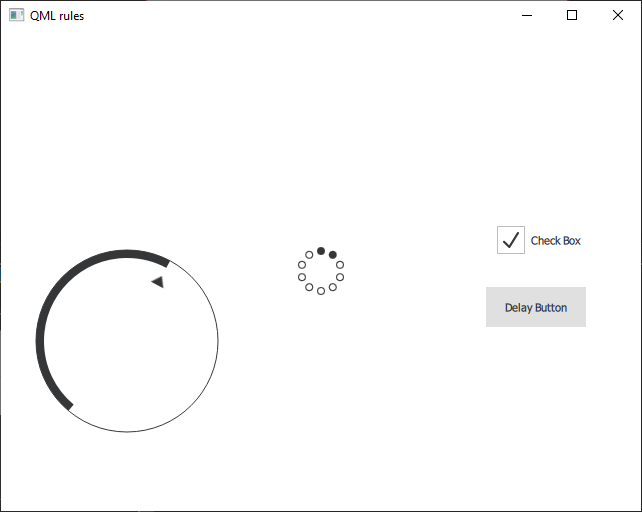
WARNING
To be done later
# QML Project Templates
WARNING
To be done later
# QML and C++ integration
- QML lives on top of C++
- You can expose C++ classes to QML
- C++ and QMl communicate via signals and slots
#include <QGuiApplication>
#include <QQmlApplicationEngine> // This loads all the QML
//Entry point of the application
int main(int argc, char *argv[])
{
// Application Attributes (this is for cell phones with high DPI screens)
QCoreApplication::setAttribute(Qt::AA_EnableHighDpiScaling);
// The Application class
QGuiApplication app(argc, argv);
// QML engine
QQmlApplicationEngine engine;
// The URL of the QML file, notice this is a compiled resource.
// Bassically it loads the QML file as a String into the engine that runs it as QML
const QUrl url(QStringLiteral("qrc:/main.qml"));
// Connecting a signal and slot - making sure the object and url match
QObject::connect(&engine, &QQmlApplicationEngine::objectCreated,
&app, [url](QObject *obj, const QUrl &objUrl) {
if (!obj && url == objUrl)
QCoreApplication::exit(-1);
}, Qt::QueuedConnection);
// The engine loading the QML file
engine.load(url);
// The application entering an event loop that keeps the application open
return app.exec();
}
2
3
4
5
6
7
8
9
10
11
12
13
14
15
16
17
18
19
20
21
22
23
24
25
26
27
28
29
30
31
32
# Call C++ Slot from QML
First create a function with a slot, in this case will be the Test function.
public slots:
void bark();
2
then, include on main.cpp:
#include <QQmlContext>
#include <test.h>
2
Then create an instance of the function and add the instance to the root context:
Test test;
engine.rootContext()->setContextProperty("testing", &test);
2
Now you can call the slot from the QML file:
onClicked: {
//Call a slot
testing.bark();
}
2
3
4
CMakeLists:
cmake_minimum_required(VERSION 3.14)
project(QT5 LANGUAGES CXX)
set(CMAKE_INCLUDE_CURRENT_DIR ON)
set(CMAKE_AUTOUIC ON)
set(CMAKE_AUTOMOC ON)
set(CMAKE_AUTORCC ON)
set(CMAKE_CXX_STANDARD 17)
set(CMAKE_CXX_STANDARD_REQUIRED ON)
# QtCreator supports the following variables for Android, which are identical to qmake Android variables.
# Check http://doc.qt.io/qt-5/deployment-android.html for more information.
# They need to be set before the find_package(Qt5 ...) call.
#if(ANDROID)
# set(ANDROID_PACKAGE_SOURCE_DIR "${CMAKE_CURRENT_SOURCE_DIR}/android")
# if (ANDROID_ABI STREQUAL "armeabi-v7a")
# set(ANDROID_EXTRA_LIBS
# ${CMAKE_CURRENT_SOURCE_DIR}/path/to/libcrypto.so
# ${CMAKE_CURRENT_SOURCE_DIR}/path/to/libssl.so)
# endif()
#endif()
find_package(QT NAMES Qt6 Qt5 COMPONENTS Core Quick REQUIRED)
find_package(Qt${QT_VERSION_MAJOR} COMPONENTS Core Quick QuickControls2 REQUIRED)
if(ANDROID)
add_library(QT5 SHARED
main.cpp
qml.qrc
test.cpp
test.h
)
else()
add_executable(QT5
main.cpp
qml.qrc
test.cpp
test.h
)
endif()
target_compile_definitions(QT5
PRIVATE $<$<OR:$<CONFIG:Debug>,$<CONFIG:RelWithDebInfo>>:QT_QML_DEBUG>)
target_link_libraries(QT5
PRIVATE Qt${QT_VERSION_MAJOR}::Core Qt${QT_VERSION_MAJOR}::Quick Qt5::QuickControls2)
2
3
4
5
6
7
8
9
10
11
12
13
14
15
16
17
18
19
20
21
22
23
24
25
26
27
28
29
30
31
32
33
34
35
36
37
38
39
40
41
42
43
44
45
46
47
48
49
Main.cpp
#include <QGuiApplication>
#include <QQmlApplicationEngine>
#include <QQuickStyle>
//imports
#include <QQmlContext>
#include <test.h>
int main(int argc, char *argv[])
{
QCoreApplication::setAttribute(Qt::AA_EnableHighDpiScaling);
QGuiApplication app(argc, argv);
QQuickStyle::setStyle("Material");
QQmlApplicationEngine engine;
//Add to the root context
Test test; // Basically we are creating a instance of the function,
engine.rootContext()->setContextProperty("testing", &test);
// Then we are taking that instance and puting on the context proterty
const QUrl url(QStringLiteral("qrc:/main.qml"));
QObject::connect(&engine, &QQmlApplicationEngine::objectCreated,
&app, [url](QObject *obj, const QUrl &objUrl) {
if (!obj && url == objUrl)
QCoreApplication::exit(-1);
}, Qt::QueuedConnection);
engine.load(url);
return app.exec();
}
2
3
4
5
6
7
8
9
10
11
12
13
14
15
16
17
18
19
20
21
22
23
24
25
26
27
28
29
30
31
32
33
main.qml
import QtQuick 2.15
import QtQuick.Window 2.15
import QtQuick.Controls 2.3
// Test
Window {
id: window
width: 640
height: 480
visible: true
title: qsTr("Hello World")
Column {
id: column
width: 200
height: 168
anchors.verticalCenter: parent.verticalCenter
anchors.horizontalCenter: parent.horizontalCenter
spacing: 25
Label {
id: label
text: qsTr("Call a C++ Slot")
anchors.horizontalCenter: parent.horizontalCenter
}
Button {
id: button
text: qsTr("Click Me")
anchors.horizontalCenter: parent.horizontalCenter
onClicked: {
//Call a slot
testing.bark();
//Can not call a non-slot - must be a property
var num = testing.number()
print(num)
}
}
}
}
2
3
4
5
6
7
8
9
10
11
12
13
14
15
16
17
18
19
20
21
22
23
24
25
26
27
28
29
30
31
32
33
34
35
36
37
38
39
40
41
42
Test.h
#ifndef TEST_H
#define TEST_H
#include <QObject>
#include <QDebug>
class Test : public QObject
{
Q_OBJECT
public:
explicit Test(QObject *parent = nullptr);
//Normal Function
int number();
signals:
public slots:
void bark();
};
#endif // TEST_H
2
3
4
5
6
7
8
9
10
11
12
13
14
15
16
17
18
19
20
21
22
23
24
Test.cpp
#include "test.h"
Test::Test(QObject *parent) : QObject(parent)
{
}
int Test::number()
{
qInfo() << "Called Number()";
return 42;
}
void Test::bark()
{
qInfo() << "Bark Bark Bark";
}
2
3
4
5
6
7
8
9
10
11
12
13
14
15
16
17
18
Output:
Bark Bark Bark
qrc:/main.qml:35: TypeError: Property 'number' of object Test(0x79fd90) is not a function
Bark Bark Bark
qrc:/main.qml:35: TypeError: Property 'number' of object Test(0x79fd90) is not a function
Bark Bark Bark
qrc:/main.qml:35: TypeError: Property 'number' of object Test(0x79fd90) is not a function
2
3
4
5
6
TIP
If something shows up as "Its not a function", first check the spelling and then check if it is a slot. QML can not call a non-slot - must be a property.
In this case the problem was that the function number() was not a slot.
# Call a QML slot from C++
Here, we're going to connect to a signal.
We have a start button a stop button and a status labels going to start a timer stop a timer and get the current timer status.
That being said we're gonna have a back in class and a signal is going to be emitted. and we're going to read or connect to that signal inside of QML and that's how this whole magic happens.
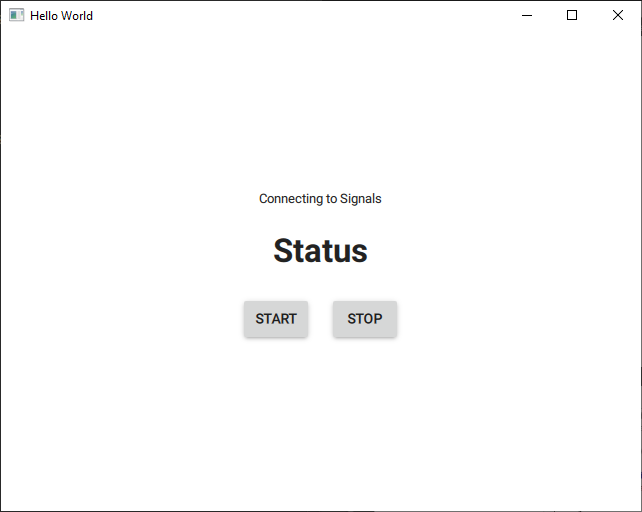
TIP
it is important we use QVariant, Because the data we pass back and forth from C++ to QML is going to be
wrapped inside of a QVariant.
main.qml
import QtQuick 2.15
import QtQuick.Window 2.15
import QtQuick.Controls 2.3
// This is the root context
Window {
id: window
width: 640
height: 480
visible: true
title: qsTr("Hello World")
property string timerlabel: "Counter"
Connections {
target: testing //our C++ object on the root context
onNotice: {
console.log("Slot called from C++")
timerlabel = data // get this from the signal
if(data === "Starting...") labelStatus.text = "Counter Started"
if(data === "Stopped") labelStatus.text = "Counter Stopped"
}
}
Column {
id: column
width: 228
height: 159
anchors.verticalCenter: parent.verticalCenter
anchors.horizontalCenter: parent.horizontalCenter
spacing: 25
Label {
id: labelTitle
text: "Connecting to Signals"
font.pointSize: 10
anchors.horizontalCenter: parent.horizontalCenter
}
Label {
id: labelStatus
text: "Status"
font.pointSize: 25
font.bold: true
anchors.horizontalCenter: parent.horizontalCenter
}
Row {
id: row
spacing: 25
anchors.horizontalCenter: parent.horizontalCenter
Button {
id: buttonStart
text: qsTr("Start")
onClicked: {
//Call a slot
testing.start();
}
}
Button {
id: buttonStop
text: qsTr("Stop")
onClicked: {
//Call a slot
testing.stop();
}
}
}
Label {
id: labelCounter
text: timerlabel
font.pointSize: 20
font.bold: true
anchors.horizontalCenter: parent.horizontalCenter
}
}
}
2
3
4
5
6
7
8
9
10
11
12
13
14
15
16
17
18
19
20
21
22
23
24
25
26
27
28
29
30
31
32
33
34
35
36
37
38
39
40
41
42
43
44
45
46
47
48
49
50
51
52
53
54
55
56
57
58
59
60
61
62
63
64
65
66
67
68
69
70
71
72
73
74
75
76
77
78
79
main.cpp
#include <QGuiApplication>
#include <QQmlApplicationEngine>
#include <QQuickStyle>
//imports
#include <QQmlContext>
#include "test.h"
int main(int argc, char *argv[])
{
QCoreApplication::setAttribute(Qt::AA_EnableHighDpiScaling);
QGuiApplication app(argc, argv);
QQuickStyle::setStyle("Material");
QQmlApplicationEngine engine;
//Add to the root context
Test test; // Basically we are creating a instance of the function,
engine.rootContext()->setContextProperty("testing", &test);
// Then we are taking that instance and puting on the context proterty
const QUrl url(QStringLiteral("qrc:/main.qml"));
QObject::connect(&engine, &QQmlApplicationEngine::objectCreated,
&app, [url](QObject *obj, const QUrl &objUrl) {
if (!obj && url == objUrl)
QCoreApplication::exit(-1);
}, Qt::QueuedConnection);
engine.load(url);
return app.exec();
}
2
3
4
5
6
7
8
9
10
11
12
13
14
15
16
17
18
19
20
21
22
23
24
25
26
27
28
29
30
31
32
33
test.h
#ifndef TEST_H
#define TEST_H
#include <QObject>
#include <QDebug>
#include <QTimer>
#include <QDateTime>
#include <QVariant>
class Test : public QObject
{
Q_OBJECT
public:
explicit Test(QObject *parent = nullptr);
signals:
void notice(QVariant data);
private slots:
void timeout();
public slots:
void start();
void stop();
private:
QTimer m_timer;
QString m_display;
};
#endif // TEST_H
2
3
4
5
6
7
8
9
10
11
12
13
14
15
16
17
18
19
20
21
22
23
24
25
26
27
28
29
30
31
32
33
test.cpp
So our test class is going to create we're going to connect our signal slot we're going to configure the timer emit our initial display.
When that timer fires we're going to actually update it with the current time. Actually get the current date time and commit our notice and then starting and stopping the timer
#include "test.h"
Test::Test(QObject *parent) : QObject(parent)
{
connect(&m_timer, &QTimer::timeout, this, &Test::timeout);
m_timer.setInterval(1000);
m_display = "Starting";
qInfo() << m_display;
emit notice(QVariant(m_display));
}
void Test::timeout()
{
m_display = QDateTime::currentDateTime().toString();
qInfo() << m_display;
emit notice(QVariant(m_display));
}
void Test::start()
{
m_display = "Starting...";
emit notice(QVariant(m_display));
m_timer.start();
}
void Test::stop()
{
m_timer.stop();
m_display = "Stopped";
qInfo() << m_display;
emit notice(QVariant(m_display));
}
2
3
4
5
6
7
8
9
10
11
12
13
14
15
16
17
18
19
20
21
22
23
24
25
26
27
28
29
30
31
32
output:
"Starting"
"Wed Jan 6 10:35:30 2021"
"Wed Jan 6 10:35:31 2021"
"Wed Jan 6 10:35:32 2021"
"Wed Jan 6 10:35:33 2021"
"Wed Jan 6 10:35:34 2021"
"Wed Jan 6 10:35:35 2021"
"Stopped"
2
3
4
5
6
7
8
TIP
I don't like working with connections but this is a perfect example of why you would Somerset connections targets and you guessed it.
Our target's going to be testing and this is our C++ object on the root context so we can actually connect to this because it is a queue object and it has signals and slots.
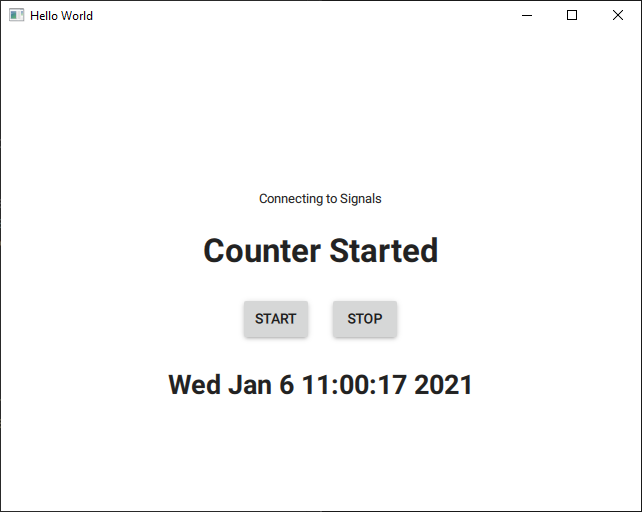
# Register a C++ Class with QML
The previous videos had a bit of a problem and that problem was putting something well globally is not really necessarily the best design practice.
So what we're gonna do is we're going to actually register a C++ class.
This is what we need to do.
We're going to register a type in QML.
we need to give it some sort of URI.
In this case it's going to be com.company.test, That's basically the namespace that we're shoving in the, tube but it's not really a namespace.
Then we're going to give it a major version a minor version and we need some sort of name that it can be used by
qmlRegisterType<Test>("com.company.test", 1, 0, "Test");
Once we get to this point this class can be created in QML.
Now this is different than previous videos where we've actually created an instance of the class and then shoved it into the context.
What we're doing now is we're saying this type test is actual class can be created inside QML.
So in the QML we import com.company.test 1.0
Now this is different than previous videos because what we're doing here is we are actually creating this inside of QML, so it's not available up in the root context, it's actually available in the context of our window , so we could actually create different versions of this in different QML files.
TIP
First and foremost, signals and slots we're not working with public and private functions.
In the main.cpp you have to follow this QML registered type give it the class type, give it a URI, major and minor version, and a name in QML that you can actually create, that's the actual QML type name.
main.cpp
#include <QGuiApplication>
#include <QQmlApplicationEngine>
#include <QQmlContext>
#include "test.h"
/*
Registering a C++ class as QML Type
allows you to use it in QML directly
*/
int main(int argc, char *argv[])
{
QCoreApplication::setAttribute(Qt::AA_EnableHighDpiScaling);
//Register a type in QML
qmlRegisterType<Test>("com.company.test", 1, 0, "Test");
QGuiApplication app(argc, argv);
QQmlApplicationEngine engine;
const QUrl url(QStringLiteral("qrc:/main.qml"));
QObject::connect(&engine, &QQmlApplicationEngine::objectCreated,
&app, [url](QObject *obj, const QUrl &objUrl) {
if (!obj && url == objUrl)
QCoreApplication::exit(-1);
}, Qt::QueuedConnection);
engine.load(url);
return app.exec();
}
2
3
4
5
6
7
8
9
10
11
12
13
14
15
16
17
18
19
20
21
22
23
24
25
26
27
28
29
30
31
32
33
main.qml
import QtQuick 2.15
import QtQuick.Window 2.15
import QtQuick.Controls 2.3
// This is the root context
import com.company.test 1.0
Window {
id: window
width: 640
height: 480
visible: true
title: qsTr("Hello World")
Test {
id: test
onStatus: labelStatus.text = data;
}
Column {
id: column
width: 228
height: 159
anchors.verticalCenter: parent.verticalCenter
anchors.horizontalCenter: parent.horizontalCenter
spacing: 25
Label {
id: labelTitle
text: "Connecting to Signals"
font.pointSize: 10
anchors.horizontalCenter: parent.horizontalCenter
}
Label {
id: labelStatus
text: "Status"
font.pointSize: 25
font.bold: true
anchors.horizontalCenter: parent.horizontalCenter
}
Row {
id: row
spacing: 25
anchors.horizontalCenter: parent.horizontalCenter
Button {
id: buttonStart
text: qsTr("Start")
onClicked: {
var num = Math.round(Math.random() * 100)
test.work(num)
}
}
Button {
id: buttonStop
text: qsTr("Stop")
onClicked: {
//Call a slot
}
}
}
}
}
2
3
4
5
6
7
8
9
10
11
12
13
14
15
16
17
18
19
20
21
22
23
24
25
26
27
28
29
30
31
32
33
34
35
36
37
38
39
40
41
42
43
44
45
46
47
48
49
50
51
52
53
54
55
56
57
58
59
60
61
62
63
64
65
66
test.h
#ifndef TEST_H
#define TEST_H
#include <QObject>
#include <QDebug>
#include <QVariant>
#include <QRandomGenerator>
class Test : public QObject
{
Q_OBJECT
public:
explicit Test(QObject *parent = nullptr);
signals:
void status(QVariant data);
public slots:
void work(QVariant data);
};
#endif // TEST_H
2
3
4
5
6
7
8
9
10
11
12
13
14
15
16
17
18
19
20
21
22
23
24
test.cpp
#include "test.h"
Test::Test(QObject *parent) : QObject(parent)
{
}
void Test::work(QVariant data)
{
bool ok;
int numIn = data.toInt(&ok);
int numOut = 0;
if(!ok) {
qWarning() << "Not a valid number";
} else {
int numRand = QRandomGenerator::global()->bounded(100);
numOut = numIn * numRand;
qInfo() << "In: " << numIn;
qInfo() << "Random: " << numRand;
qInfo() << "Out: " << numOut;
}
emit status(QVariant(numOut));
}
2
3
4
5
6
7
8
9
10
11
12
13
14
15
16
17
18
19
20
21
22
23
24
25
# C++ integration example
CMakeLists
cmake_minimum_required(VERSION 3.14)
project(Cpp_Integration_Example LANGUAGES CXX)
set(CMAKE_INCLUDE_CURRENT_DIR ON)
set(CMAKE_AUTOUIC ON)
set(CMAKE_AUTOMOC ON)
set(CMAKE_AUTORCC ON)
set(CMAKE_CXX_STANDARD 17)
set(CMAKE_CXX_STANDARD_REQUIRED ON)
# QtCreator supports the following variables for Android, which are identical to qmake Android variables.
# Check http://doc.qt.io/qt-5/deployment-android.html for more information.
# They need to be set before the find_package(Qt5 ...) call.
#if(ANDROID)
# set(ANDROID_PACKAGE_SOURCE_DIR "${CMAKE_CURRENT_SOURCE_DIR}/android")
# if (ANDROID_ABI STREQUAL "armeabi-v7a")
# set(ANDROID_EXTRA_LIBS
# ${CMAKE_CURRENT_SOURCE_DIR}/path/to/libcrypto.so
# ${CMAKE_CURRENT_SOURCE_DIR}/path/to/libssl.so)
# endif()
#endif()
find_package(QT NAMES Qt6 Qt5 COMPONENTS Core Quick REQUIRED)
find_package(Qt${QT_VERSION_MAJOR} COMPONENTS Core Quick REQUIRED)
if(ANDROID)
add_library(Cpp_Integration_Example SHARED
main.cpp
qml.qrc
)
else()
add_executable(Cpp_Integration_Example
main.cpp
qml.qrc
)
endif()
target_sources(Cpp_Integration_Example
PRIVATE
machine.cpp
machine.h
)
target_compile_definitions(Cpp_Integration_Example
PRIVATE $<$<OR:$<CONFIG:Debug>,$<CONFIG:RelWithDebInfo>>:QT_QML_DEBUG>)
target_link_libraries(Cpp_Integration_Example
PRIVATE Qt${QT_VERSION_MAJOR}::Core Qt${QT_VERSION_MAJOR}::Quick)
2
3
4
5
6
7
8
9
10
11
12
13
14
15
16
17
18
19
20
21
22
23
24
25
26
27
28
29
30
31
32
33
34
35
36
37
38
39
40
41
42
43
44
45
46
47
48
49
50
51
52
53
main.cpp
#include <QGuiApplication>
#include <QQmlApplicationEngine>
#include "machine.h"
int main(int argc, char *argv[])
{
QCoreApplication::setAttribute(Qt::AA_EnableHighDpiScaling);
QGuiApplication app(argc, argv);
qmlRegisterType<Machine>("com.skinnyrobot.machine", 1, 0, "Machine");
QQmlApplicationEngine engine;
const QUrl url(QStringLiteral("qrc:/main.qml"));
QObject::connect(&engine, &QQmlApplicationEngine::objectCreated,
&app, [url](QObject *obj, const QUrl &objUrl) {
if (!obj && url == objUrl)
QCoreApplication::exit(-1);
}, Qt::QueuedConnection);
engine.load(url);
return app.exec();
}
2
3
4
5
6
7
8
9
10
11
12
13
14
15
16
17
18
19
20
21
22
23
24
machine.h
#ifndef MACHINE_H
#define MACHINE_H
#include <QObject>
#include <QTimer>
#include <QVariant>
#include <QDebug>
class Machine : public QObject
{
Q_OBJECT
Q_PROPERTY(int workload READ value WRITE setValue NOTIFY progress)
public:
explicit Machine(QObject *parent = nullptr);
int value();
void setValue(int data);
signals:
void progress();
void started();
void stopped();
void paused();
void resumed();
public slots:
void start();
void stop();
void pause();
void resume();
private slots:
void timeout();
private:
QTimer m_timer;
int m_value;
};
#endif // MACHINE_H
2
3
4
5
6
7
8
9
10
11
12
13
14
15
16
17
18
19
20
21
22
23
24
25
26
27
28
29
30
31
32
33
34
35
36
37
38
39
40
41
42
machine.cpp
#include "machine.h"
Machine::Machine(QObject *parent) : QObject(parent)
{
m_timer.setInterval(1000);
connect(&m_timer, &QTimer::timeout, this, &Machine::timeout);
}
int Machine::value()
{
qInfo() << "Returning value";
return m_value;
}
void Machine::setValue(int data)
{
qInfo() << "Setting value";
m_value = data;
emit progress();
}
void Machine::start()
{
setValue(0);
m_timer.start();
emit started();
}
void Machine::stop()
{
m_timer.stop();
emit stopped();
}
void Machine::pause()
{
m_timer.stop();
emit paused();
}
void Machine::resume()
{
m_timer.start();
emit resumed();
}
void Machine::timeout()
{
m_value++;
emit progress();
if(m_value > 99) stop();
}
2
3
4
5
6
7
8
9
10
11
12
13
14
15
16
17
18
19
20
21
22
23
24
25
26
27
28
29
30
31
32
33
34
35
36
37
38
39
40
41
42
43
44
45
46
47
48
49
50
51
52
main.qml
import QtQuick 2.12
import QtQuick.Window 2.12
import QtQuick.Controls 2.3
import com.skinnyrobot.machine 1.0
Window {
id: window
width: 640
height: 480
visible: true
title: qsTr("C++ Example")
Component.onCompleted: {
progressBar.value = machine.workload
btnStart.enable = true
btnStop.enable = false
btnPause.enable = false
btnResume.enable = false
}
Machine {
id: machine
onStarted: {
btnStart.enabled = false
btnStop.enable = true
btnPause.enabled = true
btnResume.enabled = false
lblStatus.text = "Started"
}
onStopped: {
btnStart.enabled = true
btnStop.enable = false
btnPause.enabled = false
btnResume.enabled = false
lblStatus.text = "Stopped"
progressBar.value = 0.0
}
onPaused: {
btnStart.enabled = false
btnStop.enable = true
btnPause.enabled = false
btnResume.enabled = true
lblStatus.text = "Paused"
}
onResumed: {
btnStart.enabled = false
btnStop.enable = true
btnPause.enabled = true
btnResume.enabled = false
lblStatus.text = "Resumed"
}
onProgress: {
lblStatus.text = "Progress: " + machine.workload + "%"
progressBar.value = (machine.workload * 0.01)
}
}
Column {
id:column
width: 434
height: 62
anchors.horizontalCenter: parent.horizontalCenter
anchors.verticalCenter: parent.verticalCenter
spacing: 10
Label {
id: lblStatus
text: "Status"
}
ProgressBar {
id: progressBar
width: parent.width
anchors.horizontalCenter: parent.horizontalCenter
value: 0.5
}
Row {
id: row
width: 200
height: 400
spacing: 10
Button {
id: btnStart
text: qsTr("Start")
onClicked: machine.start()
}
Button {
id: btnPause
text: qsTr("Pause")
onClicked: machine.pause()
}
Button {
id: btnResume
text: qsTr("Resume")
onClicked: machine.resume()
}
Button {
id: btnStop
text: qsTr("Stop")
onClicked: machine.stop()
}
}
}
}
2
3
4
5
6
7
8
9
10
11
12
13
14
15
16
17
18
19
20
21
22
23
24
25
26
27
28
29
30
31
32
33
34
35
36
37
38
39
40
41
42
43
44
45
46
47
48
49
50
51
52
53
54
55
56
57
58
59
60
61
62
63
64
65
66
67
68
69
70
71
72
73
74
75
76
77
78
79
80
81
82
83
84
85
86
87
88
89
90
91
92
93
94
95
96
97
98
99
100
101
102
103
104
105
106
107
108
109
110
111
112
113
114
115
116
117
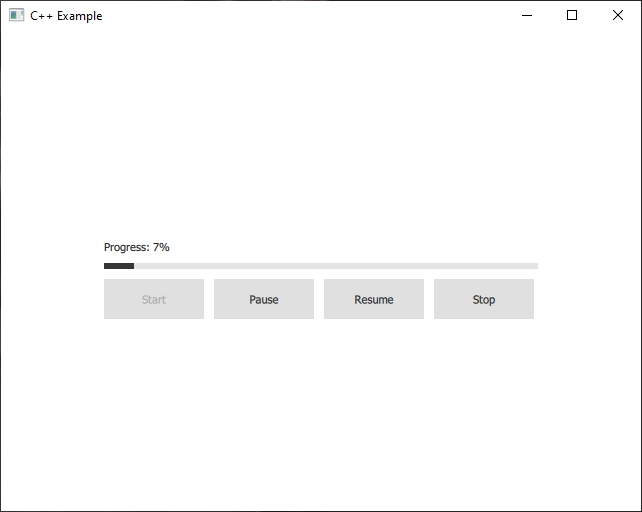
# Examples
# Square footage calculator
import QtQuick 2.15
import QtQuick.Window 2.15
import QtQuick.Controls 2.15
Window {
id: window
width: 640
height: 480
visible: true
title: qsTr("Square Footage Calculator")
function calc() {
var num = sbWidth.value * sbHeight.value
label.text = num + " sqft"
}
Column {
id: column
x: 0
y: 0
width: 200
height: 164
anchors.verticalCenter: parent.verticalCenter
anchors.horizontalCenter: parent.horizontalCenter
spacing: 10
Label {
id: label
text: qsTr("0 sqft")
anchors.horizontalCenter: parent.horizontalCenter
font.pointSize: 25
}
Grid {
id: grid
width: 400
height: 400
rows: 2
columns: 2
spacing: 10
Label {
id: label1
text: qsTr("Width")
}
SpinBox {
id: sbWidth
}
Label {
id: label2
text: qsTr("Height")
}
SpinBox {
id: sbHeight
}
}
}
Connections {
target: sbWidth
onValueModified: calc()
}
Connections {
target: sbHeight
onValueModified: calc()
}
}
2
3
4
5
6
7
8
9
10
11
12
13
14
15
16
17
18
19
20
21
22
23
24
25
26
27
28
29
30
31
32
33
34
35
36
37
38
39
40
41
42
43
44
45
46
47
48
49
50
51
52
53
54
55
56
57
58
59
60
61
62
63
64
65
66
67
68
69
70
71
72